Applied Corporate Strategy
VerifiedAdded on 2023/04/06
|24
|4558
|482
AI Summary
This report is based on the critical strategic analysis of the organization Zara online. Zara is a Spanish brand based on clothing and accessories headquartered in Spain. Amancio Ortega and Rosalia Mera founded it in the year 1975. It is the world’s largest retailer in clothing and the main brand of Inditex group.
Contribute Materials
Your contribution can guide someone’s learning journey. Share your
documents today.
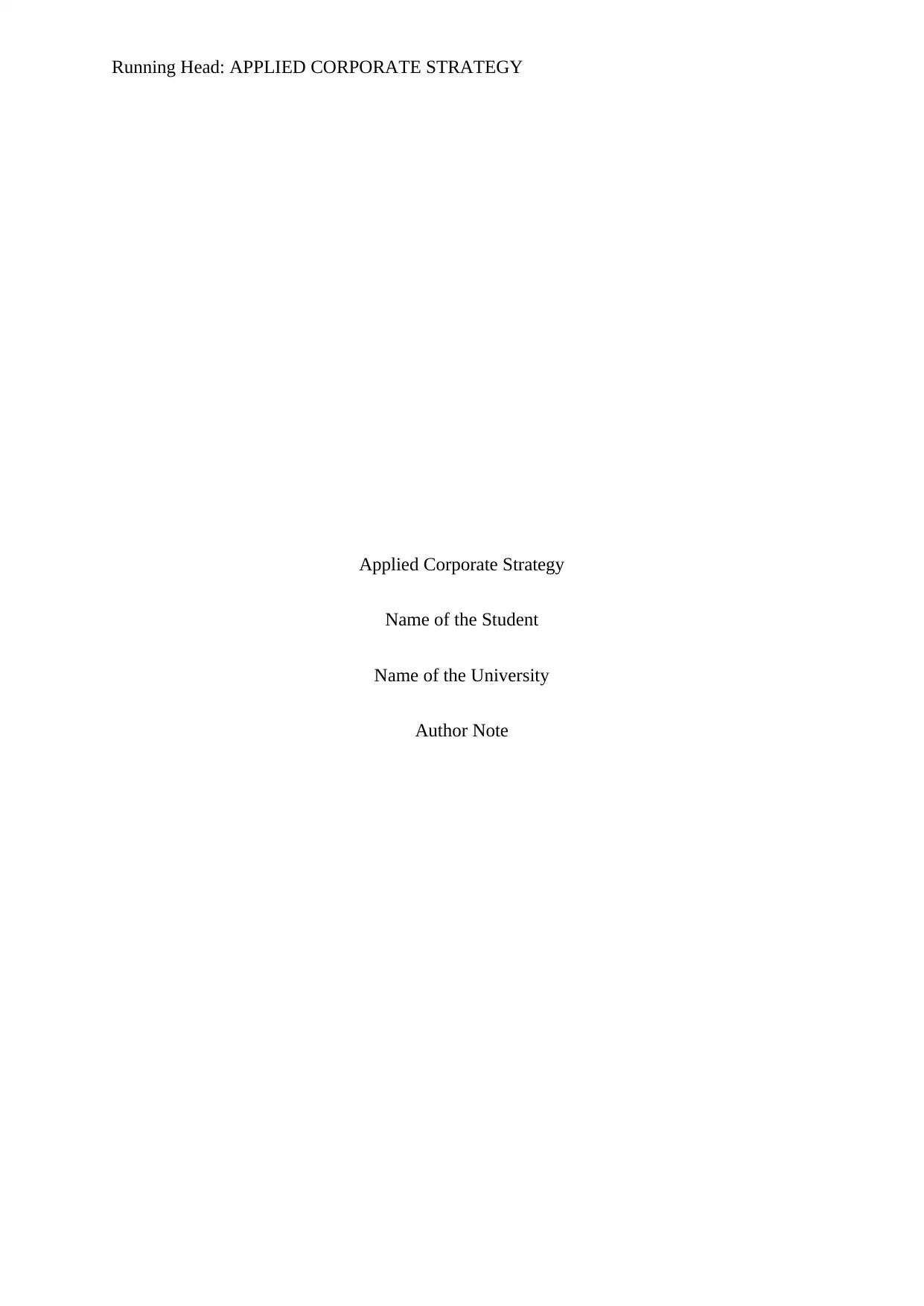
Running Head: APPLIED CORPORATE STRATEGY
Applied Corporate Strategy
Name of the Student
Name of the University
Author Note
Applied Corporate Strategy
Name of the Student
Name of the University
Author Note
Secure Best Marks with AI Grader
Need help grading? Try our AI Grader for instant feedback on your assignments.
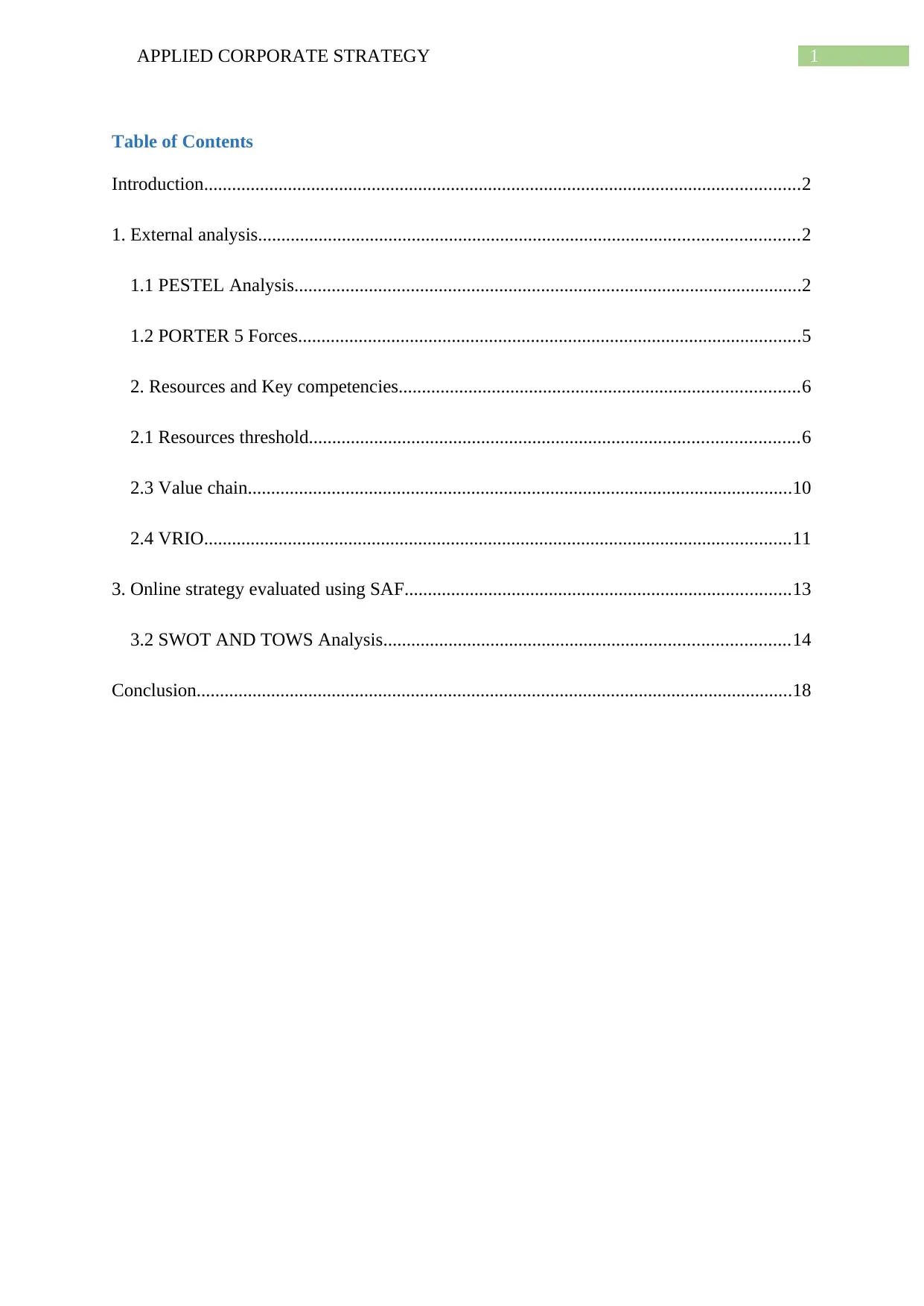
1APPLIED CORPORATE STRATEGY
Table of Contents
Introduction................................................................................................................................2
1. External analysis....................................................................................................................2
1.1 PESTEL Analysis.............................................................................................................2
1.2 PORTER 5 Forces............................................................................................................5
2. Resources and Key competencies......................................................................................6
2.1 Resources threshold.........................................................................................................6
2.3 Value chain.....................................................................................................................10
2.4 VRIO..............................................................................................................................11
3. Online strategy evaluated using SAF...................................................................................13
3.2 SWOT AND TOWS Analysis.......................................................................................14
Conclusion................................................................................................................................18
Table of Contents
Introduction................................................................................................................................2
1. External analysis....................................................................................................................2
1.1 PESTEL Analysis.............................................................................................................2
1.2 PORTER 5 Forces............................................................................................................5
2. Resources and Key competencies......................................................................................6
2.1 Resources threshold.........................................................................................................6
2.3 Value chain.....................................................................................................................10
2.4 VRIO..............................................................................................................................11
3. Online strategy evaluated using SAF...................................................................................13
3.2 SWOT AND TOWS Analysis.......................................................................................14
Conclusion................................................................................................................................18

2APPLIED CORPORATE STRATEGY
Introduction
This report is based on the critical strategic analysis of the organization Zara online.
Zara is a Spanish brand based on clothing and accessories headquartered in Spain. Amancio
Ortega and Rosalia Mera founded it in the year 1975. It is the world’s largest retailer in
clothing and the main brand of Inditex group. The revenue earned is approximately 18.9$
billion annually. It tends to manage up to 20 collections of clothing a year. It consists of
women’s and men’s clothing as well as children. Its products are supplied based on trends of
the customer. The highly successful supply chain ships its products to the retail stores twice a
week. It manufactures more than 450 million products every year. In the month of November,
it decided to expand further its online business to other countries including Austria, Belgium,
Netherlands and Ireland (Zara.com. 2019). The online strategy by Zara is to enter the new
markets through online for international expansion as it uses technology innovations like
augmented reality. Zara aims for quality over quantity for its customers. It stands out for its
authenticity and transparency. Due to huge competitive pressure from the market of online
shopping, Zara is focused on shifting to online stores and will subsequently open larger stores
in future. This report aims at discussing the detailed business strategy of Zara online.
Introduction
This report is based on the critical strategic analysis of the organization Zara online.
Zara is a Spanish brand based on clothing and accessories headquartered in Spain. Amancio
Ortega and Rosalia Mera founded it in the year 1975. It is the world’s largest retailer in
clothing and the main brand of Inditex group. The revenue earned is approximately 18.9$
billion annually. It tends to manage up to 20 collections of clothing a year. It consists of
women’s and men’s clothing as well as children. Its products are supplied based on trends of
the customer. The highly successful supply chain ships its products to the retail stores twice a
week. It manufactures more than 450 million products every year. In the month of November,
it decided to expand further its online business to other countries including Austria, Belgium,
Netherlands and Ireland (Zara.com. 2019). The online strategy by Zara is to enter the new
markets through online for international expansion as it uses technology innovations like
augmented reality. Zara aims for quality over quantity for its customers. It stands out for its
authenticity and transparency. Due to huge competitive pressure from the market of online
shopping, Zara is focused on shifting to online stores and will subsequently open larger stores
in future. This report aims at discussing the detailed business strategy of Zara online.
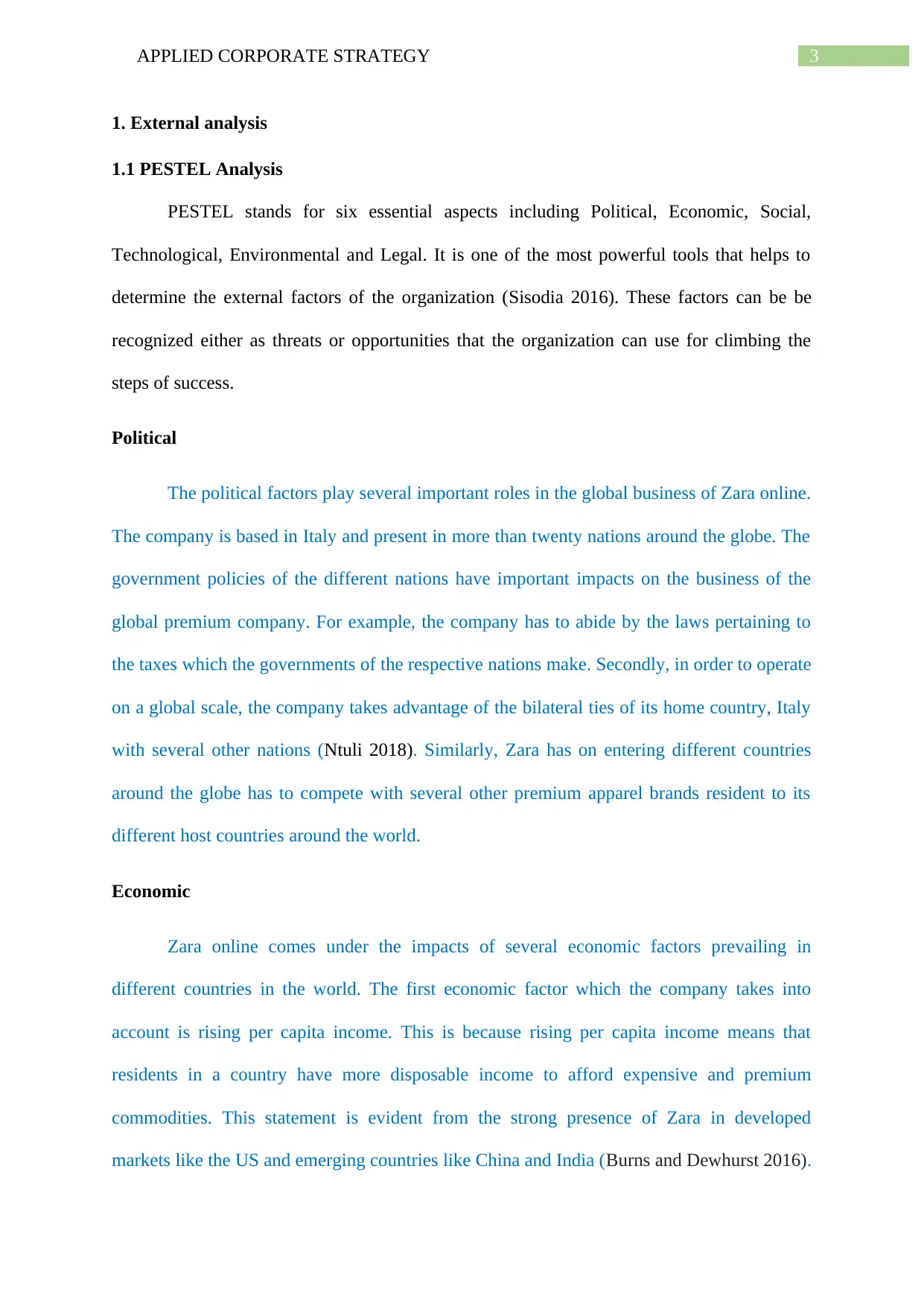
3APPLIED CORPORATE STRATEGY
1. External analysis
1.1 PESTEL Analysis
PESTEL stands for six essential aspects including Political, Economic, Social,
Technological, Environmental and Legal. It is one of the most powerful tools that helps to
determine the external factors of the organization (Sisodia 2016). These factors can be be
recognized either as threats or opportunities that the organization can use for climbing the
steps of success.
Political
The political factors play several important roles in the global business of Zara online.
The company is based in Italy and present in more than twenty nations around the globe. The
government policies of the different nations have important impacts on the business of the
global premium company. For example, the company has to abide by the laws pertaining to
the taxes which the governments of the respective nations make. Secondly, in order to operate
on a global scale, the company takes advantage of the bilateral ties of its home country, Italy
with several other nations (Ntuli 2018). Similarly, Zara has on entering different countries
around the globe has to compete with several other premium apparel brands resident to its
different host countries around the world.
Economic
Zara online comes under the impacts of several economic factors prevailing in
different countries in the world. The first economic factor which the company takes into
account is rising per capita income. This is because rising per capita income means that
residents in a country have more disposable income to afford expensive and premium
commodities. This statement is evident from the strong presence of Zara in developed
markets like the US and emerging countries like China and India (Burns and Dewhurst 2016).
1. External analysis
1.1 PESTEL Analysis
PESTEL stands for six essential aspects including Political, Economic, Social,
Technological, Environmental and Legal. It is one of the most powerful tools that helps to
determine the external factors of the organization (Sisodia 2016). These factors can be be
recognized either as threats or opportunities that the organization can use for climbing the
steps of success.
Political
The political factors play several important roles in the global business of Zara online.
The company is based in Italy and present in more than twenty nations around the globe. The
government policies of the different nations have important impacts on the business of the
global premium company. For example, the company has to abide by the laws pertaining to
the taxes which the governments of the respective nations make. Secondly, in order to operate
on a global scale, the company takes advantage of the bilateral ties of its home country, Italy
with several other nations (Ntuli 2018). Similarly, Zara has on entering different countries
around the globe has to compete with several other premium apparel brands resident to its
different host countries around the world.
Economic
Zara online comes under the impacts of several economic factors prevailing in
different countries in the world. The first economic factor which the company takes into
account is rising per capita income. This is because rising per capita income means that
residents in a country have more disposable income to afford expensive and premium
commodities. This statement is evident from the strong presence of Zara in developed
markets like the US and emerging countries like China and India (Burns and Dewhurst 2016).
Secure Best Marks with AI Grader
Need help grading? Try our AI Grader for instant feedback on your assignments.
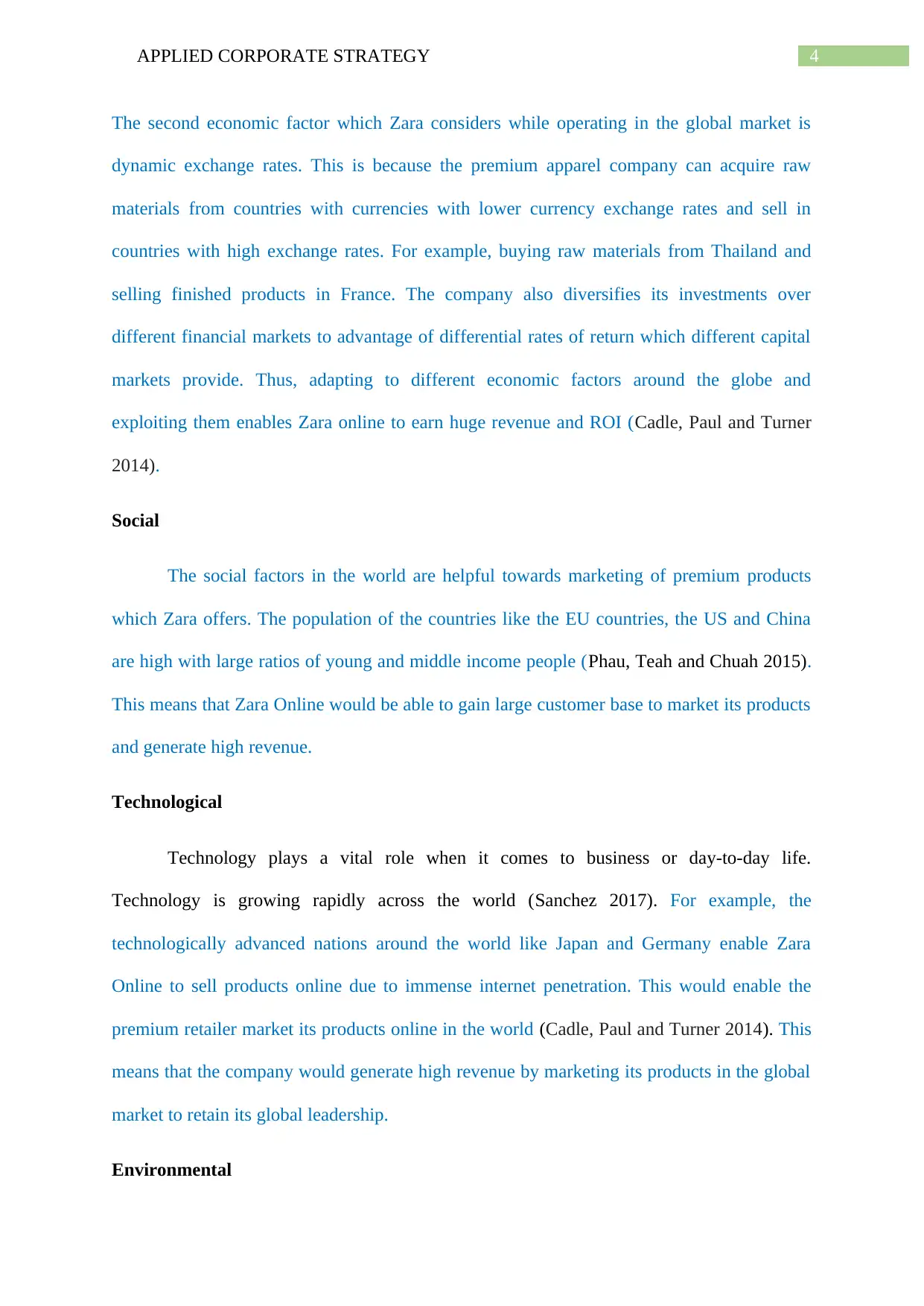
4APPLIED CORPORATE STRATEGY
The second economic factor which Zara considers while operating in the global market is
dynamic exchange rates. This is because the premium apparel company can acquire raw
materials from countries with currencies with lower currency exchange rates and sell in
countries with high exchange rates. For example, buying raw materials from Thailand and
selling finished products in France. The company also diversifies its investments over
different financial markets to advantage of differential rates of return which different capital
markets provide. Thus, adapting to different economic factors around the globe and
exploiting them enables Zara online to earn huge revenue and ROI (Cadle, Paul and Turner
2014).
Social
The social factors in the world are helpful towards marketing of premium products
which Zara offers. The population of the countries like the EU countries, the US and China
are high with large ratios of young and middle income people (Phau, Teah and Chuah 2015).
This means that Zara Online would be able to gain large customer base to market its products
and generate high revenue.
Technological
Technology plays a vital role when it comes to business or day-to-day life.
Technology is growing rapidly across the world (Sanchez 2017). For example, the
technologically advanced nations around the world like Japan and Germany enable Zara
Online to sell products online due to immense internet penetration. This would enable the
premium retailer market its products online in the world (Cadle, Paul and Turner 2014). This
means that the company would generate high revenue by marketing its products in the global
market to retain its global leadership.
Environmental
The second economic factor which Zara considers while operating in the global market is
dynamic exchange rates. This is because the premium apparel company can acquire raw
materials from countries with currencies with lower currency exchange rates and sell in
countries with high exchange rates. For example, buying raw materials from Thailand and
selling finished products in France. The company also diversifies its investments over
different financial markets to advantage of differential rates of return which different capital
markets provide. Thus, adapting to different economic factors around the globe and
exploiting them enables Zara online to earn huge revenue and ROI (Cadle, Paul and Turner
2014).
Social
The social factors in the world are helpful towards marketing of premium products
which Zara offers. The population of the countries like the EU countries, the US and China
are high with large ratios of young and middle income people (Phau, Teah and Chuah 2015).
This means that Zara Online would be able to gain large customer base to market its products
and generate high revenue.
Technological
Technology plays a vital role when it comes to business or day-to-day life.
Technology is growing rapidly across the world (Sanchez 2017). For example, the
technologically advanced nations around the world like Japan and Germany enable Zara
Online to sell products online due to immense internet penetration. This would enable the
premium retailer market its products online in the world (Cadle, Paul and Turner 2014). This
means that the company would generate high revenue by marketing its products in the global
market to retain its global leadership.
Environmental
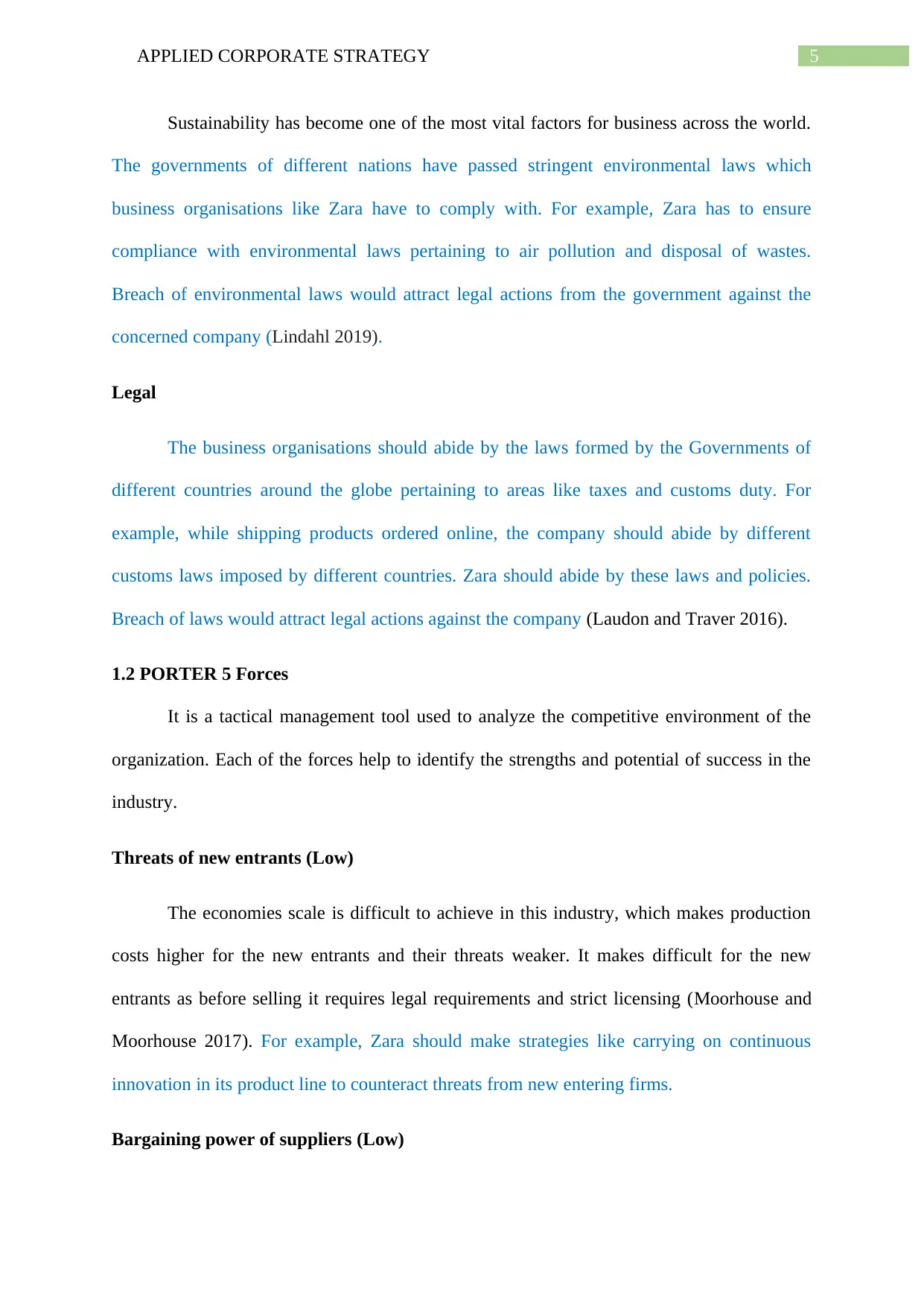
5APPLIED CORPORATE STRATEGY
Sustainability has become one of the most vital factors for business across the world.
The governments of different nations have passed stringent environmental laws which
business organisations like Zara have to comply with. For example, Zara has to ensure
compliance with environmental laws pertaining to air pollution and disposal of wastes.
Breach of environmental laws would attract legal actions from the government against the
concerned company (Lindahl 2019).
Legal
The business organisations should abide by the laws formed by the Governments of
different countries around the globe pertaining to areas like taxes and customs duty. For
example, while shipping products ordered online, the company should abide by different
customs laws imposed by different countries. Zara should abide by these laws and policies.
Breach of laws would attract legal actions against the company (Laudon and Traver 2016).
1.2 PORTER 5 Forces
It is a tactical management tool used to analyze the competitive environment of the
organization. Each of the forces help to identify the strengths and potential of success in the
industry.
Threats of new entrants (Low)
The economies scale is difficult to achieve in this industry, which makes production
costs higher for the new entrants and their threats weaker. It makes difficult for the new
entrants as before selling it requires legal requirements and strict licensing (Moorhouse and
Moorhouse 2017). For example, Zara should make strategies like carrying on continuous
innovation in its product line to counteract threats from new entering firms.
Bargaining power of suppliers (Low)
Sustainability has become one of the most vital factors for business across the world.
The governments of different nations have passed stringent environmental laws which
business organisations like Zara have to comply with. For example, Zara has to ensure
compliance with environmental laws pertaining to air pollution and disposal of wastes.
Breach of environmental laws would attract legal actions from the government against the
concerned company (Lindahl 2019).
Legal
The business organisations should abide by the laws formed by the Governments of
different countries around the globe pertaining to areas like taxes and customs duty. For
example, while shipping products ordered online, the company should abide by different
customs laws imposed by different countries. Zara should abide by these laws and policies.
Breach of laws would attract legal actions against the company (Laudon and Traver 2016).
1.2 PORTER 5 Forces
It is a tactical management tool used to analyze the competitive environment of the
organization. Each of the forces help to identify the strengths and potential of success in the
industry.
Threats of new entrants (Low)
The economies scale is difficult to achieve in this industry, which makes production
costs higher for the new entrants and their threats weaker. It makes difficult for the new
entrants as before selling it requires legal requirements and strict licensing (Moorhouse and
Moorhouse 2017). For example, Zara should make strategies like carrying on continuous
innovation in its product line to counteract threats from new entering firms.
Bargaining power of suppliers (Low)
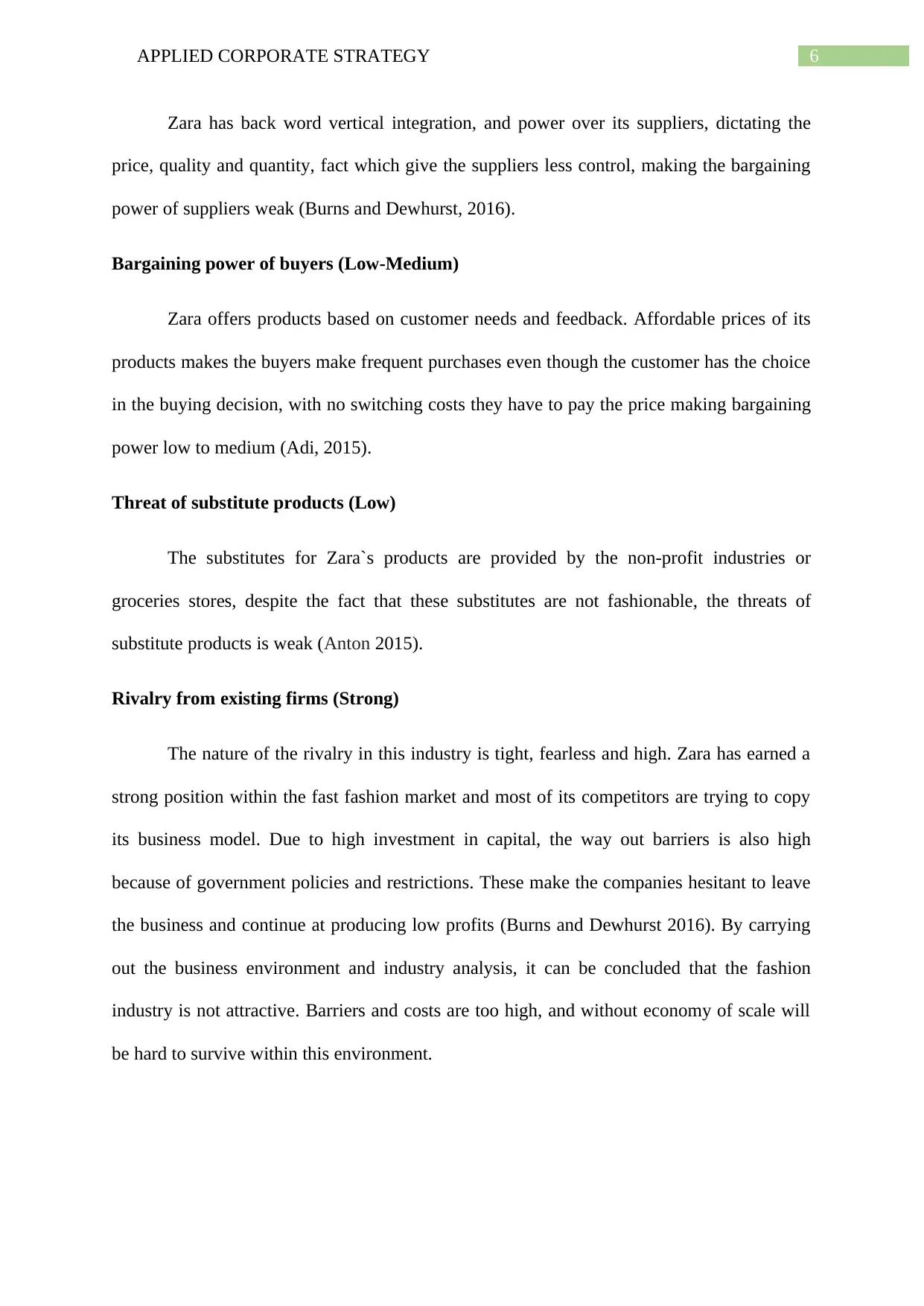
6APPLIED CORPORATE STRATEGY
Zara has back word vertical integration, and power over its suppliers, dictating the
price, quality and quantity, fact which give the suppliers less control, making the bargaining
power of suppliers weak (Burns and Dewhurst, 2016).
Bargaining power of buyers (Low-Medium)
Zara offers products based on customer needs and feedback. Affordable prices of its
products makes the buyers make frequent purchases even though the customer has the choice
in the buying decision, with no switching costs they have to pay the price making bargaining
power low to medium (Adi, 2015).
Threat of substitute products (Low)
The substitutes for Zara`s products are provided by the non-profit industries or
groceries stores, despite the fact that these substitutes are not fashionable, the threats of
substitute products is weak (Anton 2015).
Rivalry from existing firms (Strong)
The nature of the rivalry in this industry is tight, fearless and high. Zara has earned a
strong position within the fast fashion market and most of its competitors are trying to copy
its business model. Due to high investment in capital, the way out barriers is also high
because of government policies and restrictions. These make the companies hesitant to leave
the business and continue at producing low profits (Burns and Dewhurst 2016). By carrying
out the business environment and industry analysis, it can be concluded that the fashion
industry is not attractive. Barriers and costs are too high, and without economy of scale will
be hard to survive within this environment.
Zara has back word vertical integration, and power over its suppliers, dictating the
price, quality and quantity, fact which give the suppliers less control, making the bargaining
power of suppliers weak (Burns and Dewhurst, 2016).
Bargaining power of buyers (Low-Medium)
Zara offers products based on customer needs and feedback. Affordable prices of its
products makes the buyers make frequent purchases even though the customer has the choice
in the buying decision, with no switching costs they have to pay the price making bargaining
power low to medium (Adi, 2015).
Threat of substitute products (Low)
The substitutes for Zara`s products are provided by the non-profit industries or
groceries stores, despite the fact that these substitutes are not fashionable, the threats of
substitute products is weak (Anton 2015).
Rivalry from existing firms (Strong)
The nature of the rivalry in this industry is tight, fearless and high. Zara has earned a
strong position within the fast fashion market and most of its competitors are trying to copy
its business model. Due to high investment in capital, the way out barriers is also high
because of government policies and restrictions. These make the companies hesitant to leave
the business and continue at producing low profits (Burns and Dewhurst 2016). By carrying
out the business environment and industry analysis, it can be concluded that the fashion
industry is not attractive. Barriers and costs are too high, and without economy of scale will
be hard to survive within this environment.
Paraphrase This Document
Need a fresh take? Get an instant paraphrase of this document with our AI Paraphraser
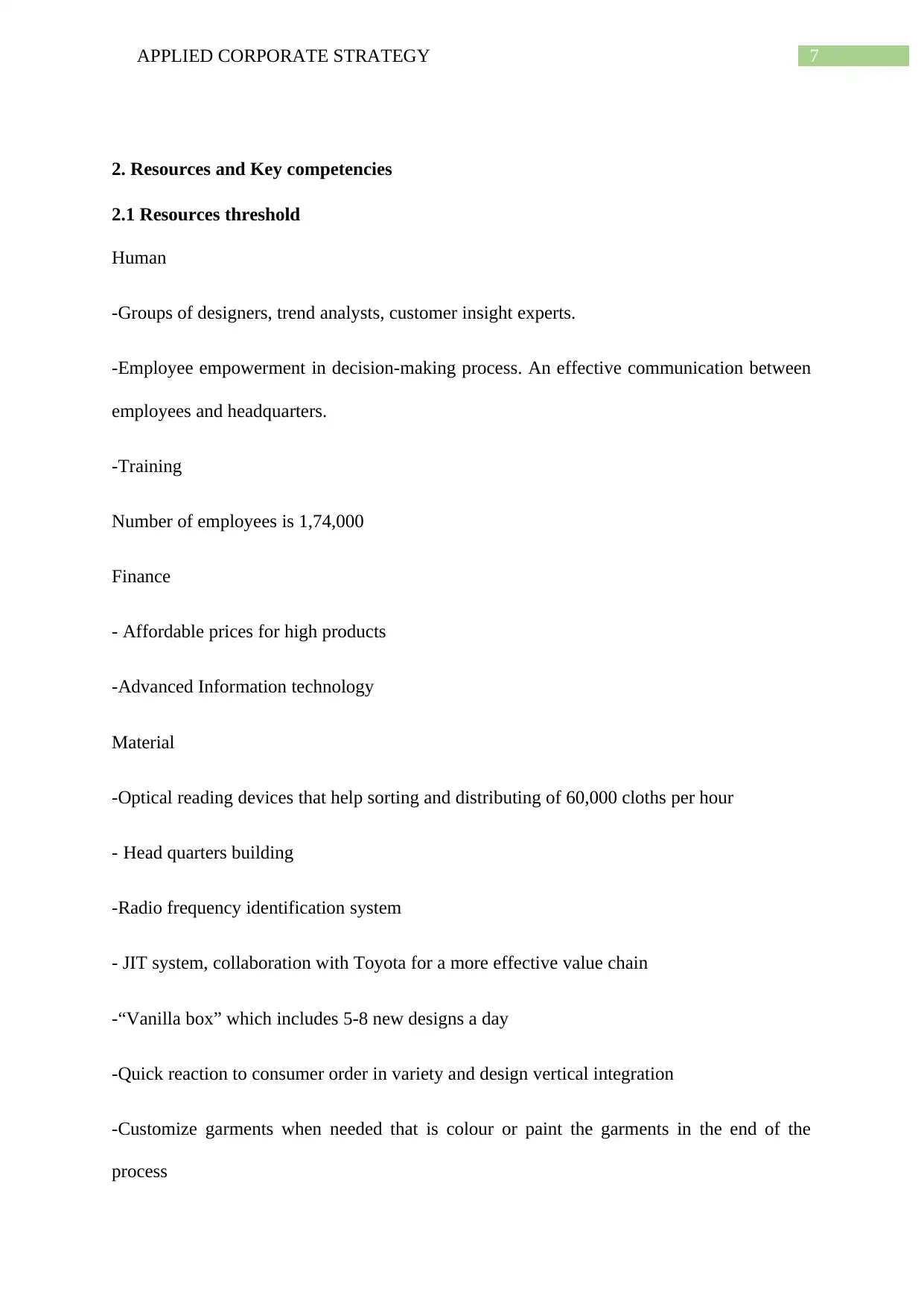
7APPLIED CORPORATE STRATEGY
2. Resources and Key competencies
2.1 Resources threshold
Human
-Groups of designers, trend analysts, customer insight experts.
-Employee empowerment in decision-making process. An effective communication between
employees and headquarters.
-Training
Number of employees is 1,74,000
Finance
- Affordable prices for high products
-Advanced Information technology
Material
-Optical reading devices that help sorting and distributing of 60,000 cloths per hour
- Head quarters building
-Radio frequency identification system
- JIT system, collaboration with Toyota for a more effective value chain
-“Vanilla box” which includes 5-8 new designs a day
-Quick reaction to consumer order in variety and design vertical integration
-Customize garments when needed that is colour or paint the garments in the end of the
process
2. Resources and Key competencies
2.1 Resources threshold
Human
-Groups of designers, trend analysts, customer insight experts.
-Employee empowerment in decision-making process. An effective communication between
employees and headquarters.
-Training
Number of employees is 1,74,000
Finance
- Affordable prices for high products
-Advanced Information technology
Material
-Optical reading devices that help sorting and distributing of 60,000 cloths per hour
- Head quarters building
-Radio frequency identification system
- JIT system, collaboration with Toyota for a more effective value chain
-“Vanilla box” which includes 5-8 new designs a day
-Quick reaction to consumer order in variety and design vertical integration
-Customize garments when needed that is colour or paint the garments in the end of the
process
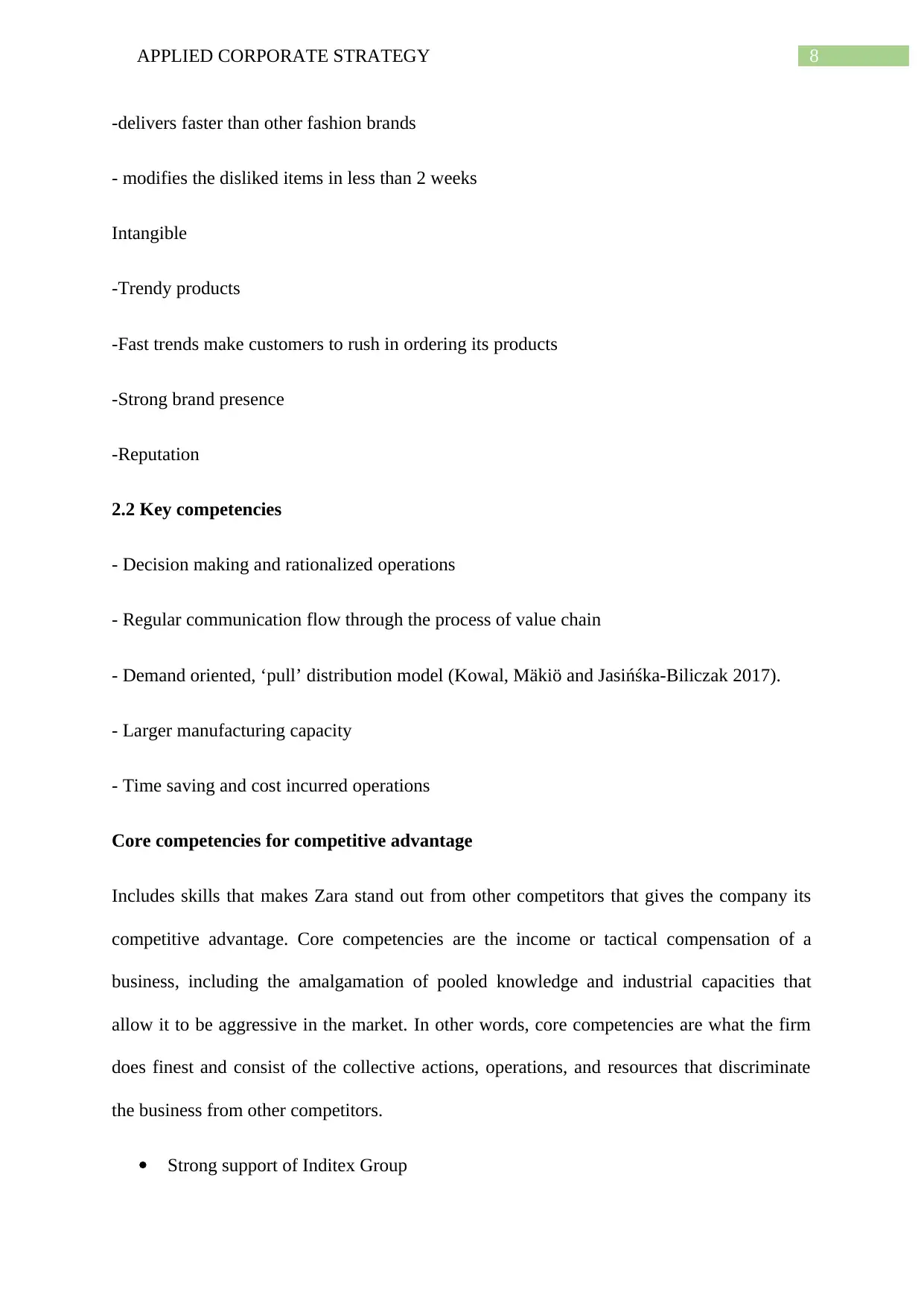
8APPLIED CORPORATE STRATEGY
-delivers faster than other fashion brands
- modifies the disliked items in less than 2 weeks
Intangible
-Trendy products
-Fast trends make customers to rush in ordering its products
-Strong brand presence
-Reputation
2.2 Key competencies
- Decision making and rationalized operations
- Regular communication flow through the process of value chain
- Demand oriented, ‘pull’ distribution model (Kowal, Mäkiö and Jasińśka-Biliczak 2017).
- Larger manufacturing capacity
- Time saving and cost incurred operations
Core competencies for competitive advantage
Includes skills that makes Zara stand out from other competitors that gives the company its
competitive advantage. Core competencies are the income or tactical compensation of a
business, including the amalgamation of pooled knowledge and industrial capacities that
allow it to be aggressive in the market. In other words, core competencies are what the firm
does finest and consist of the collective actions, operations, and resources that discriminate
the business from other competitors.
Strong support of Inditex Group
-delivers faster than other fashion brands
- modifies the disliked items in less than 2 weeks
Intangible
-Trendy products
-Fast trends make customers to rush in ordering its products
-Strong brand presence
-Reputation
2.2 Key competencies
- Decision making and rationalized operations
- Regular communication flow through the process of value chain
- Demand oriented, ‘pull’ distribution model (Kowal, Mäkiö and Jasińśka-Biliczak 2017).
- Larger manufacturing capacity
- Time saving and cost incurred operations
Core competencies for competitive advantage
Includes skills that makes Zara stand out from other competitors that gives the company its
competitive advantage. Core competencies are the income or tactical compensation of a
business, including the amalgamation of pooled knowledge and industrial capacities that
allow it to be aggressive in the market. In other words, core competencies are what the firm
does finest and consist of the collective actions, operations, and resources that discriminate
the business from other competitors.
Strong support of Inditex Group
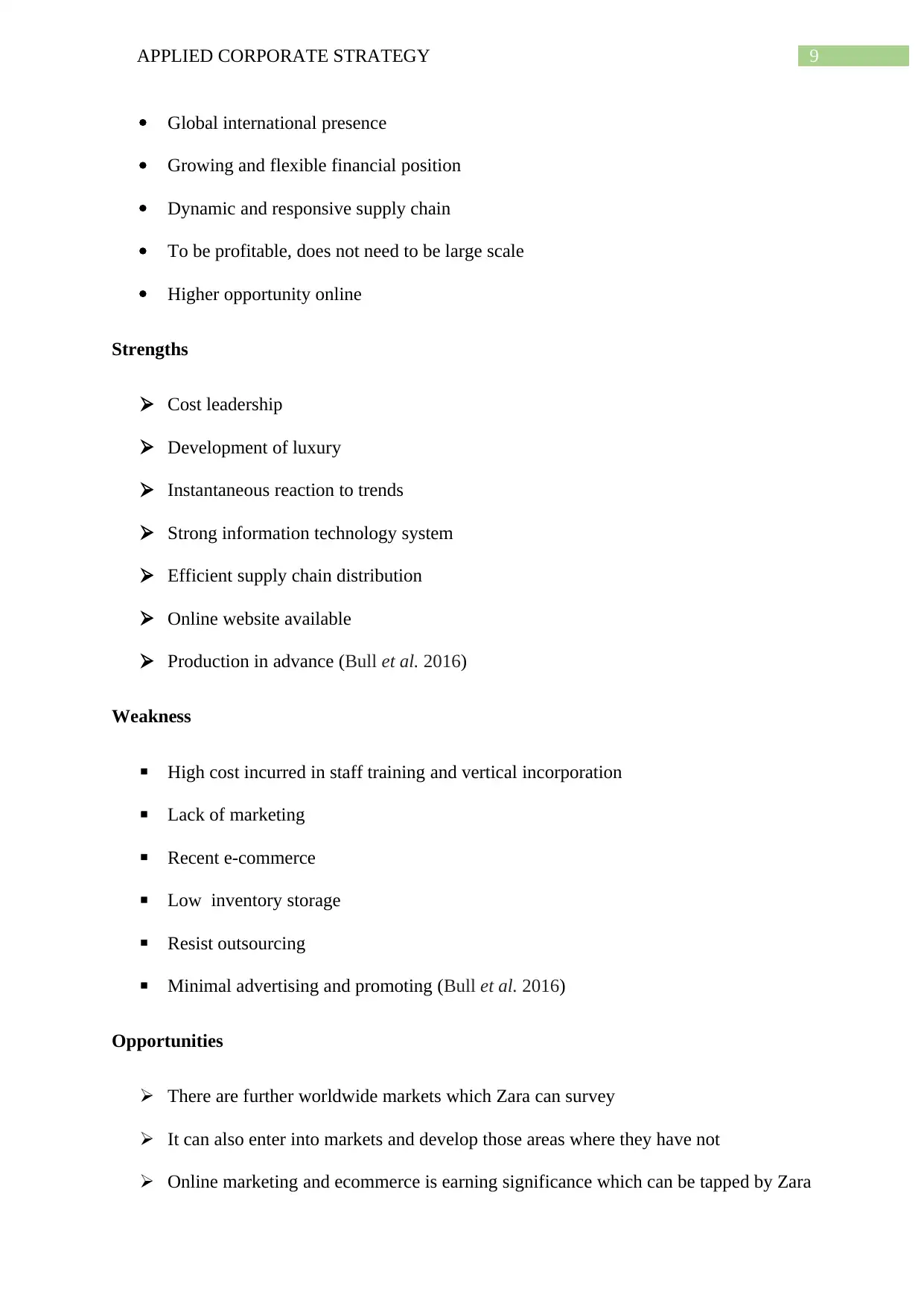
9APPLIED CORPORATE STRATEGY
Global international presence
Growing and flexible financial position
Dynamic and responsive supply chain
To be profitable, does not need to be large scale
Higher opportunity online
Strengths
Cost leadership
Development of luxury
Instantaneous reaction to trends
Strong information technology system
Efficient supply chain distribution
Online website available
Production in advance (Bull et al. 2016)
Weakness
High cost incurred in staff training and vertical incorporation
Lack of marketing
Recent e-commerce
Low inventory storage
Resist outsourcing
Minimal advertising and promoting (Bull et al. 2016)
Opportunities
There are further worldwide markets which Zara can survey
It can also enter into markets and develop those areas where they have not
Online marketing and ecommerce is earning significance which can be tapped by Zara
Global international presence
Growing and flexible financial position
Dynamic and responsive supply chain
To be profitable, does not need to be large scale
Higher opportunity online
Strengths
Cost leadership
Development of luxury
Instantaneous reaction to trends
Strong information technology system
Efficient supply chain distribution
Online website available
Production in advance (Bull et al. 2016)
Weakness
High cost incurred in staff training and vertical incorporation
Lack of marketing
Recent e-commerce
Low inventory storage
Resist outsourcing
Minimal advertising and promoting (Bull et al. 2016)
Opportunities
There are further worldwide markets which Zara can survey
It can also enter into markets and develop those areas where they have not
Online marketing and ecommerce is earning significance which can be tapped by Zara
Secure Best Marks with AI Grader
Need help grading? Try our AI Grader for instant feedback on your assignments.
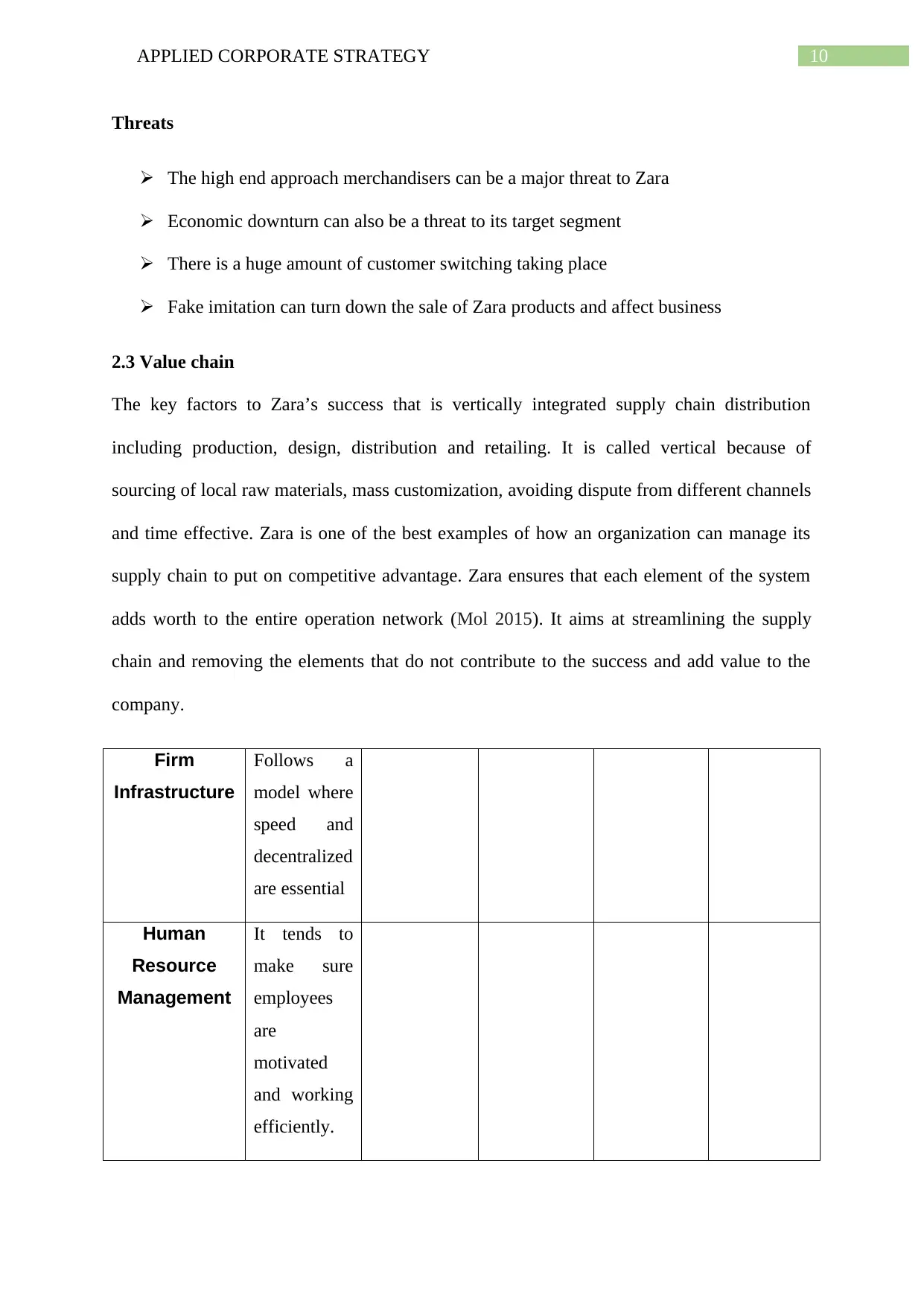
10APPLIED CORPORATE STRATEGY
Threats
The high end approach merchandisers can be a major threat to Zara
Economic downturn can also be a threat to its target segment
There is a huge amount of customer switching taking place
Fake imitation can turn down the sale of Zara products and affect business
2.3 Value chain
The key factors to Zara’s success that is vertically integrated supply chain distribution
including production, design, distribution and retailing. It is called vertical because of
sourcing of local raw materials, mass customization, avoiding dispute from different channels
and time effective. Zara is one of the best examples of how an organization can manage its
supply chain to put on competitive advantage. Zara ensures that each element of the system
adds worth to the entire operation network (Mol 2015). It aims at streamlining the supply
chain and removing the elements that do not contribute to the success and add value to the
company.
Firm
Infrastructure
Follows a
model where
speed and
decentralized
are essential
Human
Resource
Management
It tends to
make sure
employees
are
motivated
and working
efficiently.
Threats
The high end approach merchandisers can be a major threat to Zara
Economic downturn can also be a threat to its target segment
There is a huge amount of customer switching taking place
Fake imitation can turn down the sale of Zara products and affect business
2.3 Value chain
The key factors to Zara’s success that is vertically integrated supply chain distribution
including production, design, distribution and retailing. It is called vertical because of
sourcing of local raw materials, mass customization, avoiding dispute from different channels
and time effective. Zara is one of the best examples of how an organization can manage its
supply chain to put on competitive advantage. Zara ensures that each element of the system
adds worth to the entire operation network (Mol 2015). It aims at streamlining the supply
chain and removing the elements that do not contribute to the success and add value to the
company.
Firm
Infrastructure
Follows a
model where
speed and
decentralized
are essential
Human
Resource
Management
It tends to
make sure
employees
are
motivated
and working
efficiently.

11APPLIED CORPORATE STRATEGY
Technological
Development
Uses
personal
digital
assistance
for constant
information
flow
Procurement Has good
relationship
with the
suppliers
Inbound
Logistics
Operations Outbound
Logistics
Marketing
& Sales
Service
Vertical
integrated
group
controls
most of the
supply chain
Capital
intensive
industry than
other
companies
The
merchandise
get
distributed to
the stores
decided by
the
commercials
Controls
cost of
promotion
by word of
mouth
Increase the
sales
volume by
online
delivery
2.4 VRIO
Competitive advantage is the superiority of the organization over other relevant
competitors. The main aim and objective of a business is to achieve competitive advantage
sustainably. The VRIO framework stands for Valuable, Rare, Imitable and Organized to be
exploited helps to determine the core competencies of the organization.
Value
Technological
Development
Uses
personal
digital
assistance
for constant
information
flow
Procurement Has good
relationship
with the
suppliers
Inbound
Logistics
Operations Outbound
Logistics
Marketing
& Sales
Service
Vertical
integrated
group
controls
most of the
supply chain
Capital
intensive
industry than
other
companies
The
merchandise
get
distributed to
the stores
decided by
the
commercials
Controls
cost of
promotion
by word of
mouth
Increase the
sales
volume by
online
delivery
2.4 VRIO
Competitive advantage is the superiority of the organization over other relevant
competitors. The main aim and objective of a business is to achieve competitive advantage
sustainably. The VRIO framework stands for Valuable, Rare, Imitable and Organized to be
exploited helps to determine the core competencies of the organization.
Value
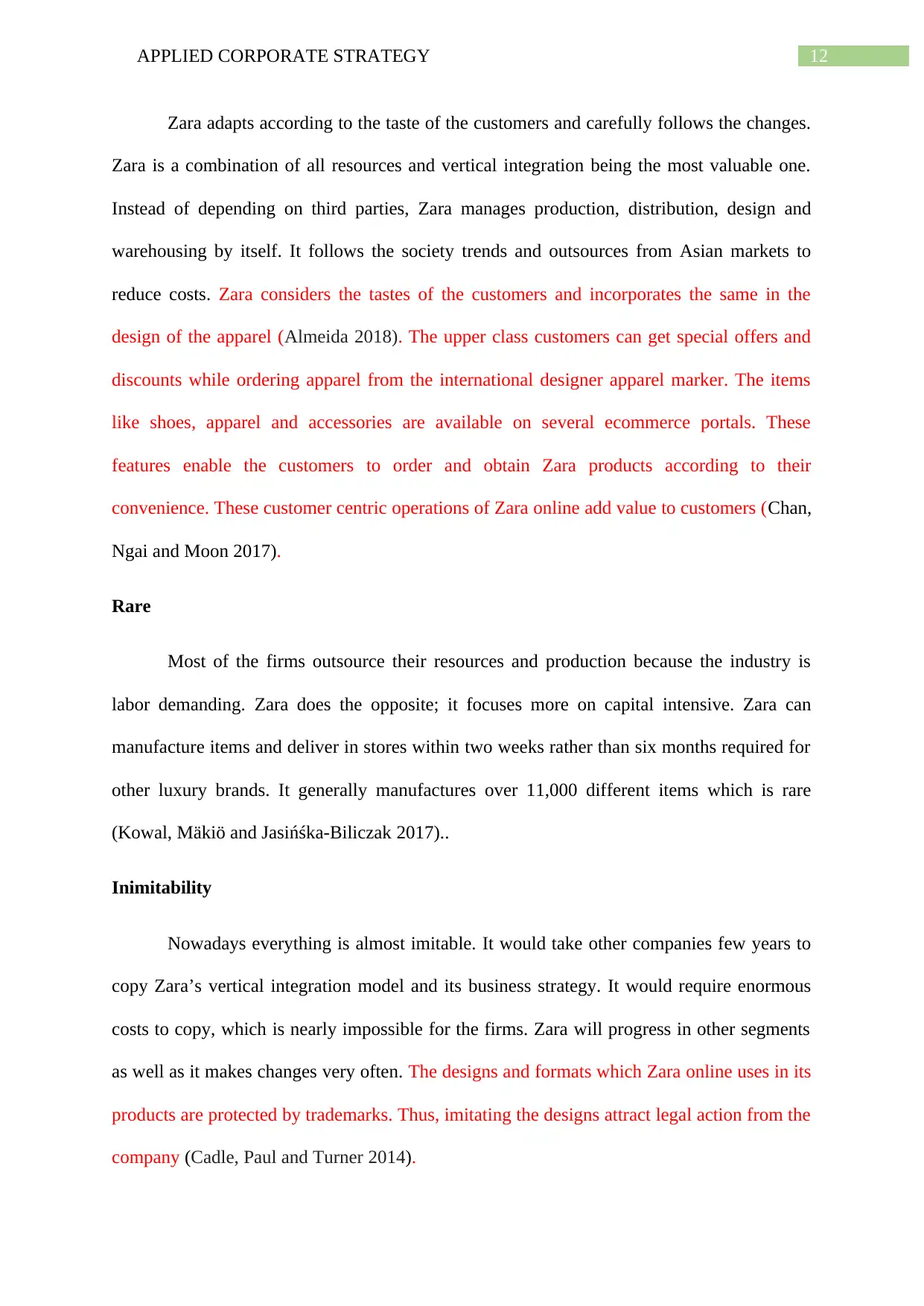
12APPLIED CORPORATE STRATEGY
Zara adapts according to the taste of the customers and carefully follows the changes.
Zara is a combination of all resources and vertical integration being the most valuable one.
Instead of depending on third parties, Zara manages production, distribution, design and
warehousing by itself. It follows the society trends and outsources from Asian markets to
reduce costs. Zara considers the tastes of the customers and incorporates the same in the
design of the apparel (Almeida 2018). The upper class customers can get special offers and
discounts while ordering apparel from the international designer apparel marker. The items
like shoes, apparel and accessories are available on several ecommerce portals. These
features enable the customers to order and obtain Zara products according to their
convenience. These customer centric operations of Zara online add value to customers (Chan,
Ngai and Moon 2017).
Rare
Most of the firms outsource their resources and production because the industry is
labor demanding. Zara does the opposite; it focuses more on capital intensive. Zara can
manufacture items and deliver in stores within two weeks rather than six months required for
other luxury brands. It generally manufactures over 11,000 different items which is rare
(Kowal, Mäkiö and Jasińśka-Biliczak 2017)..
Inimitability
Nowadays everything is almost imitable. It would take other companies few years to
copy Zara’s vertical integration model and its business strategy. It would require enormous
costs to copy, which is nearly impossible for the firms. Zara will progress in other segments
as well as it makes changes very often. The designs and formats which Zara online uses in its
products are protected by trademarks. Thus, imitating the designs attract legal action from the
company (Cadle, Paul and Turner 2014).
Zara adapts according to the taste of the customers and carefully follows the changes.
Zara is a combination of all resources and vertical integration being the most valuable one.
Instead of depending on third parties, Zara manages production, distribution, design and
warehousing by itself. It follows the society trends and outsources from Asian markets to
reduce costs. Zara considers the tastes of the customers and incorporates the same in the
design of the apparel (Almeida 2018). The upper class customers can get special offers and
discounts while ordering apparel from the international designer apparel marker. The items
like shoes, apparel and accessories are available on several ecommerce portals. These
features enable the customers to order and obtain Zara products according to their
convenience. These customer centric operations of Zara online add value to customers (Chan,
Ngai and Moon 2017).
Rare
Most of the firms outsource their resources and production because the industry is
labor demanding. Zara does the opposite; it focuses more on capital intensive. Zara can
manufacture items and deliver in stores within two weeks rather than six months required for
other luxury brands. It generally manufactures over 11,000 different items which is rare
(Kowal, Mäkiö and Jasińśka-Biliczak 2017)..
Inimitability
Nowadays everything is almost imitable. It would take other companies few years to
copy Zara’s vertical integration model and its business strategy. It would require enormous
costs to copy, which is nearly impossible for the firms. Zara will progress in other segments
as well as it makes changes very often. The designs and formats which Zara online uses in its
products are protected by trademarks. Thus, imitating the designs attract legal action from the
company (Cadle, Paul and Turner 2014).
Paraphrase This Document
Need a fresh take? Get an instant paraphrase of this document with our AI Paraphraser
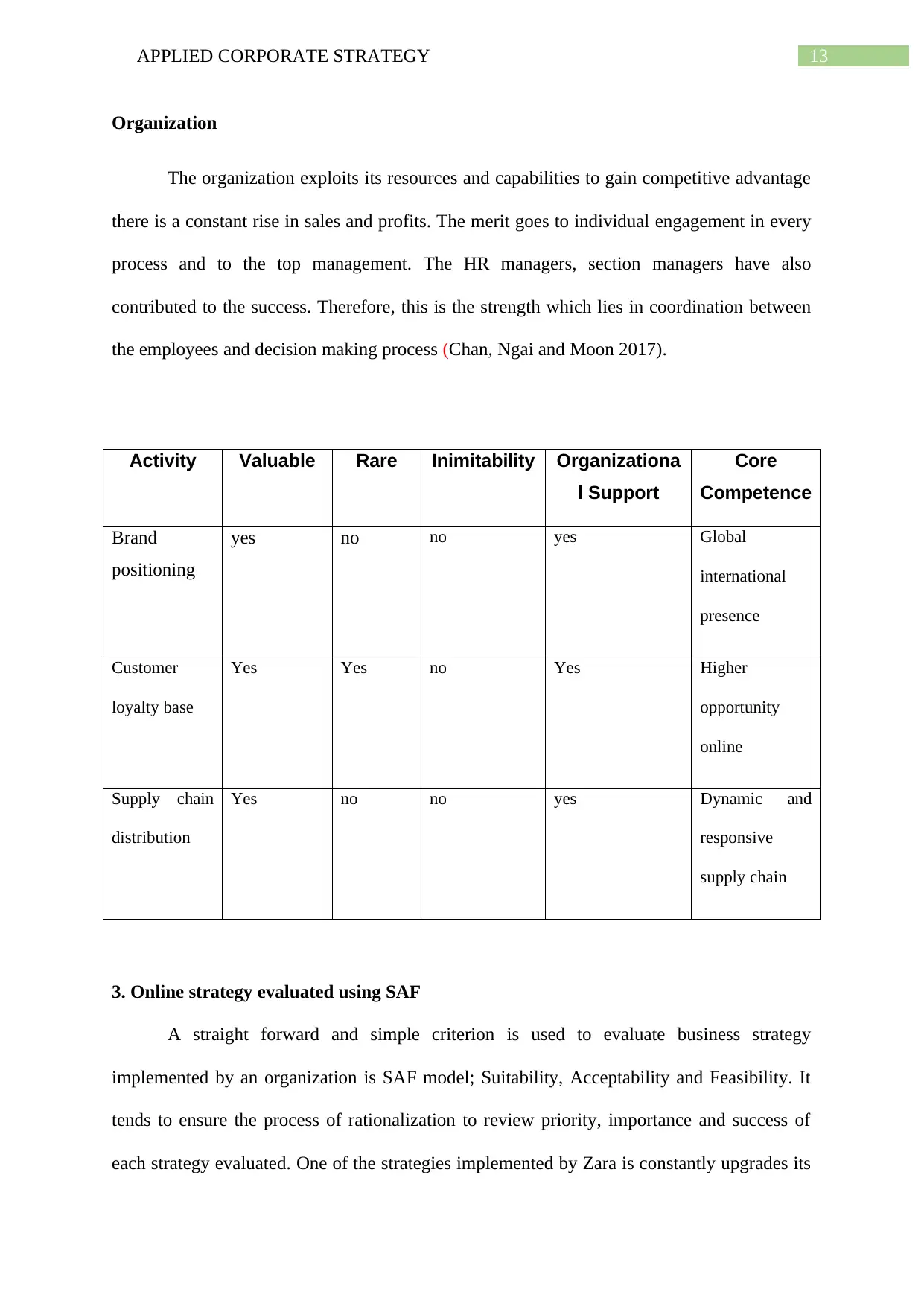
13APPLIED CORPORATE STRATEGY
Organization
The organization exploits its resources and capabilities to gain competitive advantage
there is a constant rise in sales and profits. The merit goes to individual engagement in every
process and to the top management. The HR managers, section managers have also
contributed to the success. Therefore, this is the strength which lies in coordination between
the employees and decision making process (Chan, Ngai and Moon 2017).
Activity Valuable Rare Inimitability Organizationa
l Support
Core
Competence
Brand
positioning
yes no no yes Global
international
presence
Customer
loyalty base
Yes Yes no Yes Higher
opportunity
online
Supply chain
distribution
Yes no no yes Dynamic and
responsive
supply chain
3. Online strategy evaluated using SAF
A straight forward and simple criterion is used to evaluate business strategy
implemented by an organization is SAF model; Suitability, Acceptability and Feasibility. It
tends to ensure the process of rationalization to review priority, importance and success of
each strategy evaluated. One of the strategies implemented by Zara is constantly upgrades its
Organization
The organization exploits its resources and capabilities to gain competitive advantage
there is a constant rise in sales and profits. The merit goes to individual engagement in every
process and to the top management. The HR managers, section managers have also
contributed to the success. Therefore, this is the strength which lies in coordination between
the employees and decision making process (Chan, Ngai and Moon 2017).
Activity Valuable Rare Inimitability Organizationa
l Support
Core
Competence
Brand
positioning
yes no no yes Global
international
presence
Customer
loyalty base
Yes Yes no Yes Higher
opportunity
online
Supply chain
distribution
Yes no no yes Dynamic and
responsive
supply chain
3. Online strategy evaluated using SAF
A straight forward and simple criterion is used to evaluate business strategy
implemented by an organization is SAF model; Suitability, Acceptability and Feasibility. It
tends to ensure the process of rationalization to review priority, importance and success of
each strategy evaluated. One of the strategies implemented by Zara is constantly upgrades its

14APPLIED CORPORATE STRATEGY
designs and range of products according to the requirement of the customers (Buckley 2016).
The fashion industry is updating itself with different quality and premium products with high
competition between fashion brands and online websites. Therefore, it is important to
implement changes to maintain its position and reputation in the market to sustain its growth
and future in the long run (Cadle, Paul and Turner 2014).
3.2 SWOT AND TOWS Analysis
Strengths
Cost leadership
Development of luxury
Online website
Weakness
Lack of marketing
Low inventory storage
Resist outsourcing
Opportunities
More global markets
E commerce and online marketing
Enter niche segments
Threats
o Economic downturn
o Fake imitations
o Large consumer switching
TOWS Matrix
The TOWS Matrix is derivative from the SWOT model, which aims at developing tactical
options from external-internal analysis, in the fields of business management and marketing.
Strengths
Vertically integrated system
Weakness
Lack of marketing
Centralized distribution
designs and range of products according to the requirement of the customers (Buckley 2016).
The fashion industry is updating itself with different quality and premium products with high
competition between fashion brands and online websites. Therefore, it is important to
implement changes to maintain its position and reputation in the market to sustain its growth
and future in the long run (Cadle, Paul and Turner 2014).
3.2 SWOT AND TOWS Analysis
Strengths
Cost leadership
Development of luxury
Online website
Weakness
Lack of marketing
Low inventory storage
Resist outsourcing
Opportunities
More global markets
E commerce and online marketing
Enter niche segments
Threats
o Economic downturn
o Fake imitations
o Large consumer switching
TOWS Matrix
The TOWS Matrix is derivative from the SWOT model, which aims at developing tactical
options from external-internal analysis, in the fields of business management and marketing.
Strengths
Vertically integrated system
Weakness
Lack of marketing
Centralized distribution
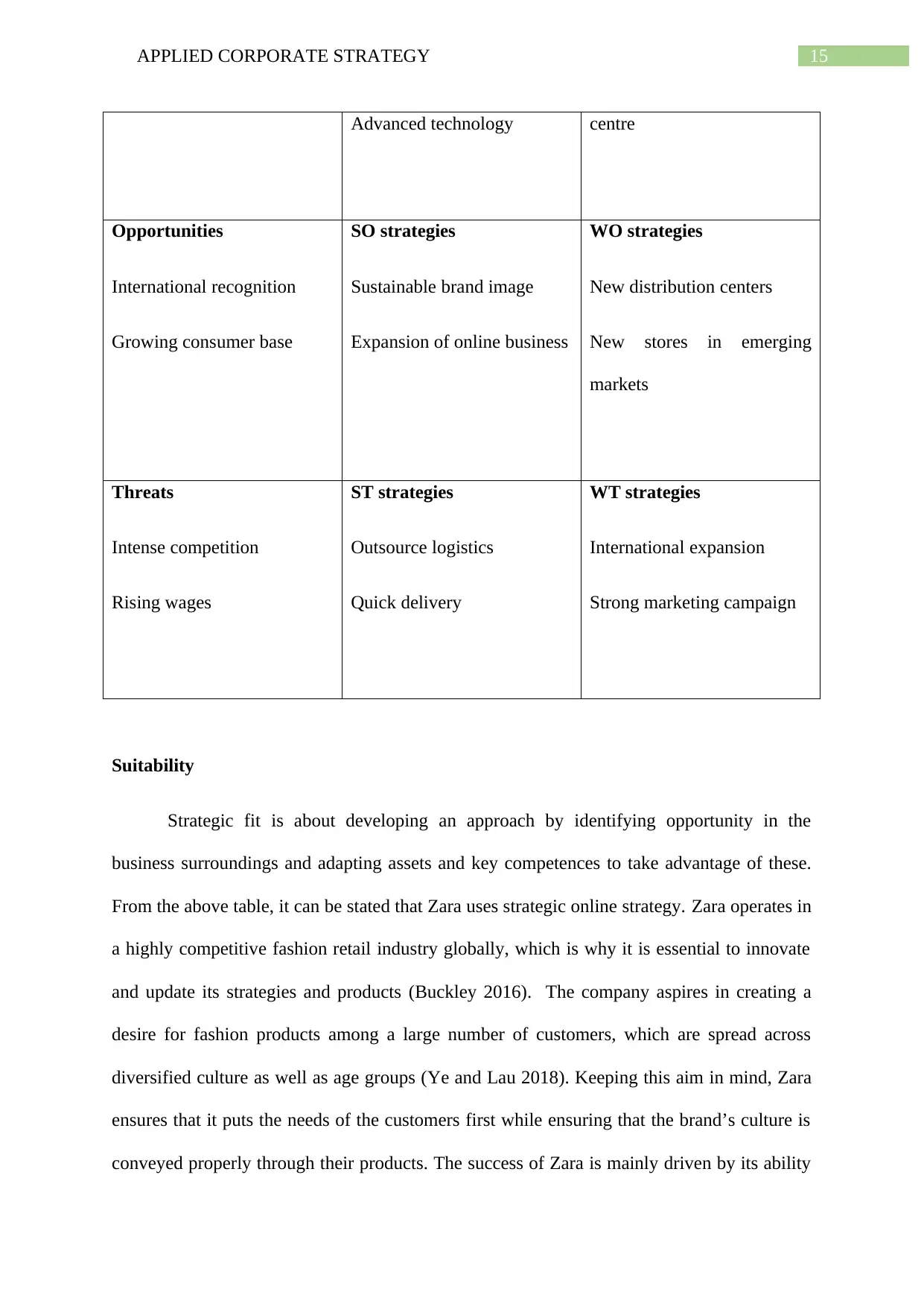
15APPLIED CORPORATE STRATEGY
Advanced technology centre
Opportunities
International recognition
Growing consumer base
SO strategies
Sustainable brand image
Expansion of online business
WO strategies
New distribution centers
New stores in emerging
markets
Threats
Intense competition
Rising wages
ST strategies
Outsource logistics
Quick delivery
WT strategies
International expansion
Strong marketing campaign
Suitability
Strategic fit is about developing an approach by identifying opportunity in the
business surroundings and adapting assets and key competences to take advantage of these.
From the above table, it can be stated that Zara uses strategic online strategy. Zara operates in
a highly competitive fashion retail industry globally, which is why it is essential to innovate
and update its strategies and products (Buckley 2016). The company aspires in creating a
desire for fashion products among a large number of customers, which are spread across
diversified culture as well as age groups (Ye and Lau 2018). Keeping this aim in mind, Zara
ensures that it puts the needs of the customers first while ensuring that the brand’s culture is
conveyed properly through their products. The success of Zara is mainly driven by its ability
Advanced technology centre
Opportunities
International recognition
Growing consumer base
SO strategies
Sustainable brand image
Expansion of online business
WO strategies
New distribution centers
New stores in emerging
markets
Threats
Intense competition
Rising wages
ST strategies
Outsource logistics
Quick delivery
WT strategies
International expansion
Strong marketing campaign
Suitability
Strategic fit is about developing an approach by identifying opportunity in the
business surroundings and adapting assets and key competences to take advantage of these.
From the above table, it can be stated that Zara uses strategic online strategy. Zara operates in
a highly competitive fashion retail industry globally, which is why it is essential to innovate
and update its strategies and products (Buckley 2016). The company aspires in creating a
desire for fashion products among a large number of customers, which are spread across
diversified culture as well as age groups (Ye and Lau 2018). Keeping this aim in mind, Zara
ensures that it puts the needs of the customers first while ensuring that the brand’s culture is
conveyed properly through their products. The success of Zara is mainly driven by its ability
Secure Best Marks with AI Grader
Need help grading? Try our AI Grader for instant feedback on your assignments.
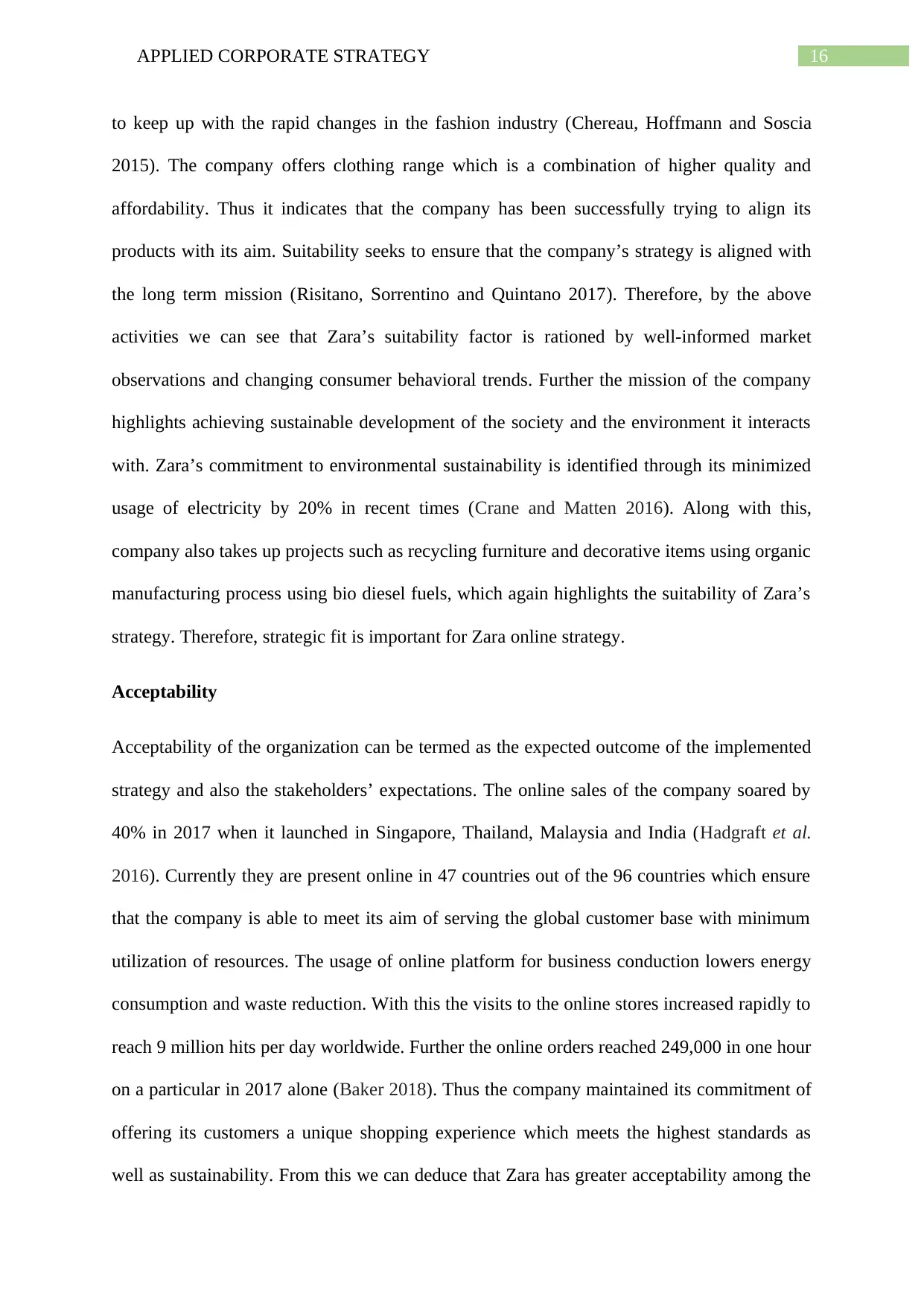
16APPLIED CORPORATE STRATEGY
to keep up with the rapid changes in the fashion industry (Chereau, Hoffmann and Soscia
2015). The company offers clothing range which is a combination of higher quality and
affordability. Thus it indicates that the company has been successfully trying to align its
products with its aim. Suitability seeks to ensure that the company’s strategy is aligned with
the long term mission (Risitano, Sorrentino and Quintano 2017). Therefore, by the above
activities we can see that Zara’s suitability factor is rationed by well-informed market
observations and changing consumer behavioral trends. Further the mission of the company
highlights achieving sustainable development of the society and the environment it interacts
with. Zara’s commitment to environmental sustainability is identified through its minimized
usage of electricity by 20% in recent times (Crane and Matten 2016). Along with this,
company also takes up projects such as recycling furniture and decorative items using organic
manufacturing process using bio diesel fuels, which again highlights the suitability of Zara’s
strategy. Therefore, strategic fit is important for Zara online strategy.
Acceptability
Acceptability of the organization can be termed as the expected outcome of the implemented
strategy and also the stakeholders’ expectations. The online sales of the company soared by
40% in 2017 when it launched in Singapore, Thailand, Malaysia and India (Hadgraft et al.
2016). Currently they are present online in 47 countries out of the 96 countries which ensure
that the company is able to meet its aim of serving the global customer base with minimum
utilization of resources. The usage of online platform for business conduction lowers energy
consumption and waste reduction. With this the visits to the online stores increased rapidly to
reach 9 million hits per day worldwide. Further the online orders reached 249,000 in one hour
on a particular in 2017 alone (Baker 2018). Thus the company maintained its commitment of
offering its customers a unique shopping experience which meets the highest standards as
well as sustainability. From this we can deduce that Zara has greater acceptability among the
to keep up with the rapid changes in the fashion industry (Chereau, Hoffmann and Soscia
2015). The company offers clothing range which is a combination of higher quality and
affordability. Thus it indicates that the company has been successfully trying to align its
products with its aim. Suitability seeks to ensure that the company’s strategy is aligned with
the long term mission (Risitano, Sorrentino and Quintano 2017). Therefore, by the above
activities we can see that Zara’s suitability factor is rationed by well-informed market
observations and changing consumer behavioral trends. Further the mission of the company
highlights achieving sustainable development of the society and the environment it interacts
with. Zara’s commitment to environmental sustainability is identified through its minimized
usage of electricity by 20% in recent times (Crane and Matten 2016). Along with this,
company also takes up projects such as recycling furniture and decorative items using organic
manufacturing process using bio diesel fuels, which again highlights the suitability of Zara’s
strategy. Therefore, strategic fit is important for Zara online strategy.
Acceptability
Acceptability of the organization can be termed as the expected outcome of the implemented
strategy and also the stakeholders’ expectations. The online sales of the company soared by
40% in 2017 when it launched in Singapore, Thailand, Malaysia and India (Hadgraft et al.
2016). Currently they are present online in 47 countries out of the 96 countries which ensure
that the company is able to meet its aim of serving the global customer base with minimum
utilization of resources. The usage of online platform for business conduction lowers energy
consumption and waste reduction. With this the visits to the online stores increased rapidly to
reach 9 million hits per day worldwide. Further the online orders reached 249,000 in one hour
on a particular in 2017 alone (Baker 2018). Thus the company maintained its commitment of
offering its customers a unique shopping experience which meets the highest standards as
well as sustainability. From this we can deduce that Zara has greater acceptability among the
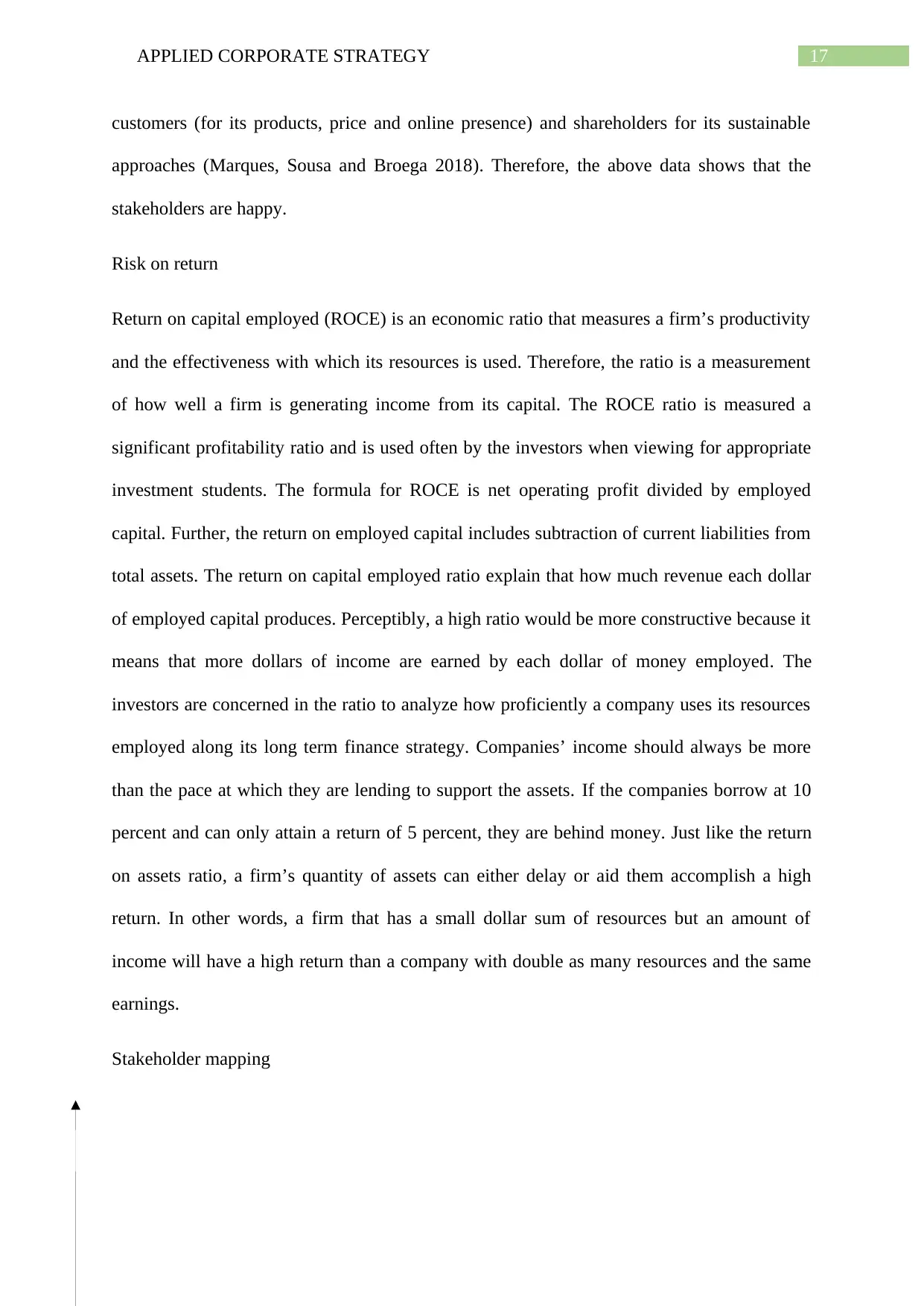
17APPLIED CORPORATE STRATEGY
customers (for its products, price and online presence) and shareholders for its sustainable
approaches (Marques, Sousa and Broega 2018). Therefore, the above data shows that the
stakeholders are happy.
Risk on return
Return on capital employed (ROCE) is an economic ratio that measures a firm’s productivity
and the effectiveness with which its resources is used. Therefore, the ratio is a measurement
of how well a firm is generating income from its capital. The ROCE ratio is measured a
significant profitability ratio and is used often by the investors when viewing for appropriate
investment students. The formula for ROCE is net operating profit divided by employed
capital. Further, the return on employed capital includes subtraction of current liabilities from
total assets. The return on capital employed ratio explain that how much revenue each dollar
of employed capital produces. Perceptibly, a high ratio would be more constructive because it
means that more dollars of income are earned by each dollar of money employed. The
investors are concerned in the ratio to analyze how proficiently a company uses its resources
employed along its long term finance strategy. Companies’ income should always be more
than the pace at which they are lending to support the assets. If the companies borrow at 10
percent and can only attain a return of 5 percent, they are behind money. Just like the return
on assets ratio, a firm’s quantity of assets can either delay or aid them accomplish a high
return. In other words, a firm that has a small dollar sum of resources but an amount of
income will have a high return than a company with double as many resources and the same
earnings.
Stakeholder mapping
customers (for its products, price and online presence) and shareholders for its sustainable
approaches (Marques, Sousa and Broega 2018). Therefore, the above data shows that the
stakeholders are happy.
Risk on return
Return on capital employed (ROCE) is an economic ratio that measures a firm’s productivity
and the effectiveness with which its resources is used. Therefore, the ratio is a measurement
of how well a firm is generating income from its capital. The ROCE ratio is measured a
significant profitability ratio and is used often by the investors when viewing for appropriate
investment students. The formula for ROCE is net operating profit divided by employed
capital. Further, the return on employed capital includes subtraction of current liabilities from
total assets. The return on capital employed ratio explain that how much revenue each dollar
of employed capital produces. Perceptibly, a high ratio would be more constructive because it
means that more dollars of income are earned by each dollar of money employed. The
investors are concerned in the ratio to analyze how proficiently a company uses its resources
employed along its long term finance strategy. Companies’ income should always be more
than the pace at which they are lending to support the assets. If the companies borrow at 10
percent and can only attain a return of 5 percent, they are behind money. Just like the return
on assets ratio, a firm’s quantity of assets can either delay or aid them accomplish a high
return. In other words, a firm that has a small dollar sum of resources but an amount of
income will have a high return than a company with double as many resources and the same
earnings.
Stakeholder mapping
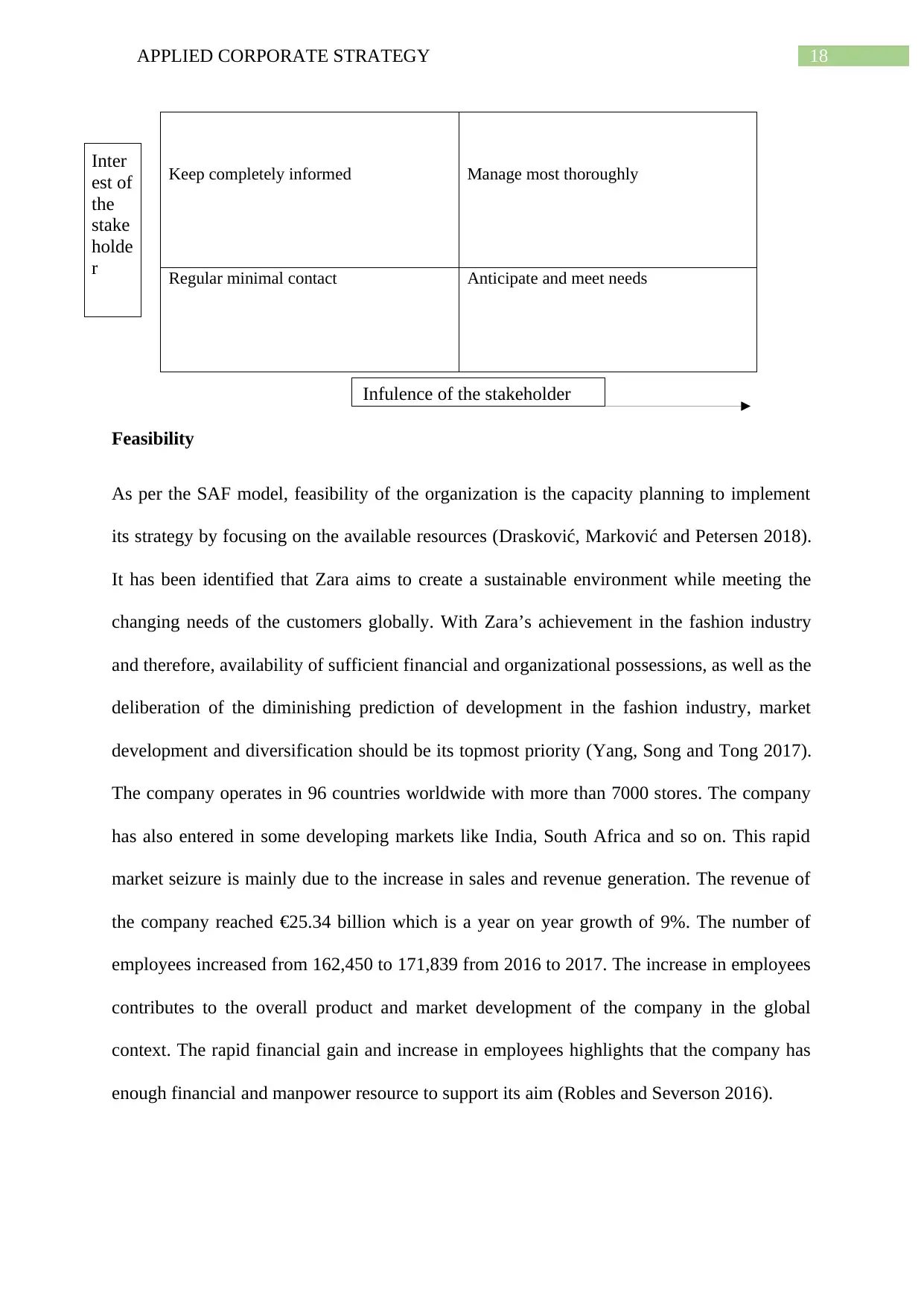
18APPLIED CORPORATE STRATEGY
Keep completely informed Manage most thoroughly
Regular minimal contact Anticipate and meet needs
Feasibility
As per the SAF model, feasibility of the organization is the capacity planning to implement
its strategy by focusing on the available resources (Drasković, Marković and Petersen 2018).
It has been identified that Zara aims to create a sustainable environment while meeting the
changing needs of the customers globally. With Zara’s achievement in the fashion industry
and therefore, availability of sufficient financial and organizational possessions, as well as the
deliberation of the diminishing prediction of development in the fashion industry, market
development and diversification should be its topmost priority (Yang, Song and Tong 2017).
The company operates in 96 countries worldwide with more than 7000 stores. The company
has also entered in some developing markets like India, South Africa and so on. This rapid
market seizure is mainly due to the increase in sales and revenue generation. The revenue of
the company reached €25.34 billion which is a year on year growth of 9%. The number of
employees increased from 162,450 to 171,839 from 2016 to 2017. The increase in employees
contributes to the overall product and market development of the company in the global
context. The rapid financial gain and increase in employees highlights that the company has
enough financial and manpower resource to support its aim (Robles and Severson 2016).
Inter
est of
the
stake
holde
r
Infulence of the stakeholder
Keep completely informed Manage most thoroughly
Regular minimal contact Anticipate and meet needs
Feasibility
As per the SAF model, feasibility of the organization is the capacity planning to implement
its strategy by focusing on the available resources (Drasković, Marković and Petersen 2018).
It has been identified that Zara aims to create a sustainable environment while meeting the
changing needs of the customers globally. With Zara’s achievement in the fashion industry
and therefore, availability of sufficient financial and organizational possessions, as well as the
deliberation of the diminishing prediction of development in the fashion industry, market
development and diversification should be its topmost priority (Yang, Song and Tong 2017).
The company operates in 96 countries worldwide with more than 7000 stores. The company
has also entered in some developing markets like India, South Africa and so on. This rapid
market seizure is mainly due to the increase in sales and revenue generation. The revenue of
the company reached €25.34 billion which is a year on year growth of 9%. The number of
employees increased from 162,450 to 171,839 from 2016 to 2017. The increase in employees
contributes to the overall product and market development of the company in the global
context. The rapid financial gain and increase in employees highlights that the company has
enough financial and manpower resource to support its aim (Robles and Severson 2016).
Inter
est of
the
stake
holde
r
Infulence of the stakeholder
Paraphrase This Document
Need a fresh take? Get an instant paraphrase of this document with our AI Paraphraser
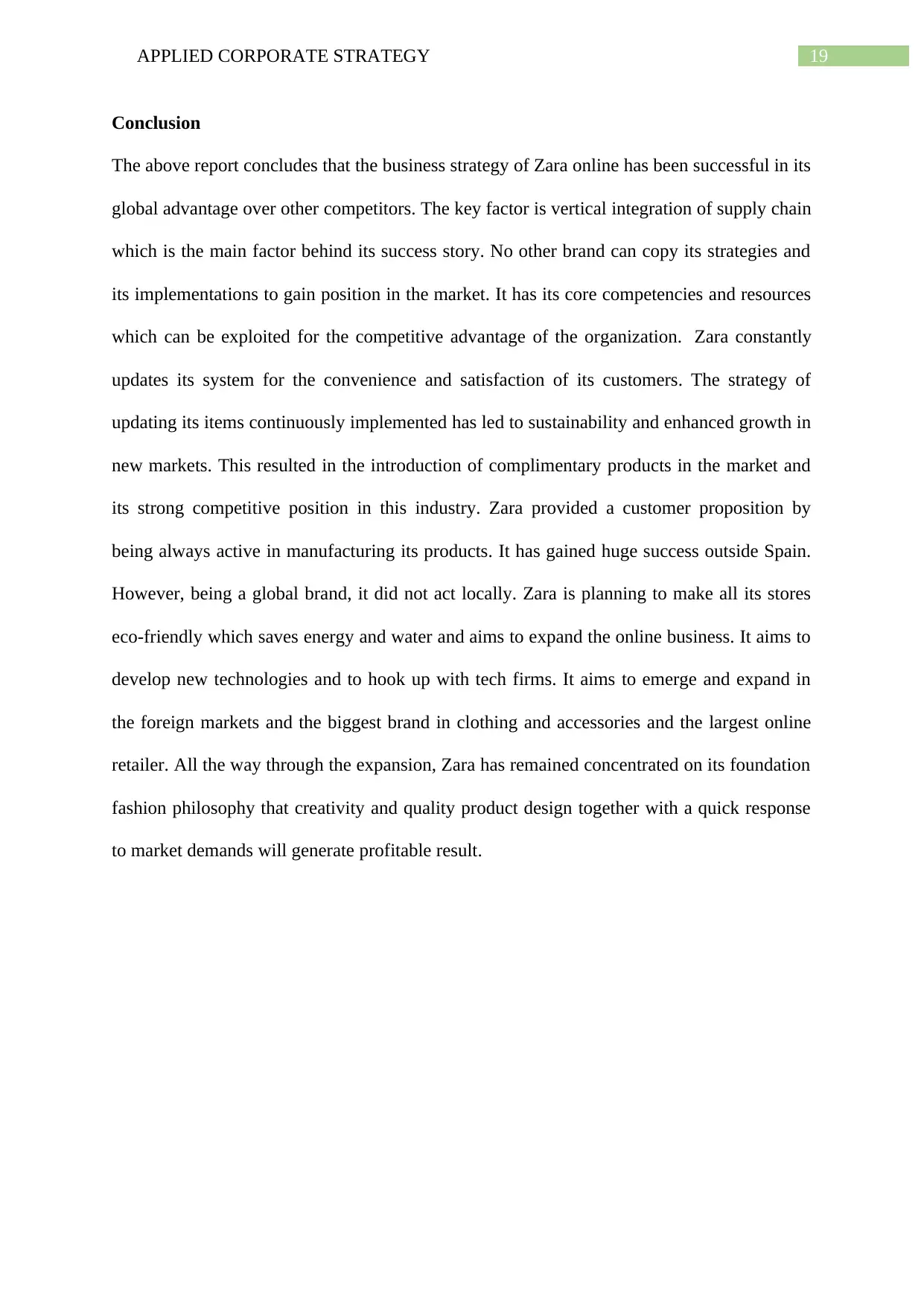
19APPLIED CORPORATE STRATEGY
Conclusion
The above report concludes that the business strategy of Zara online has been successful in its
global advantage over other competitors. The key factor is vertical integration of supply chain
which is the main factor behind its success story. No other brand can copy its strategies and
its implementations to gain position in the market. It has its core competencies and resources
which can be exploited for the competitive advantage of the organization. Zara constantly
updates its system for the convenience and satisfaction of its customers. The strategy of
updating its items continuously implemented has led to sustainability and enhanced growth in
new markets. This resulted in the introduction of complimentary products in the market and
its strong competitive position in this industry. Zara provided a customer proposition by
being always active in manufacturing its products. It has gained huge success outside Spain.
However, being a global brand, it did not act locally. Zara is planning to make all its stores
eco-friendly which saves energy and water and aims to expand the online business. It aims to
develop new technologies and to hook up with tech firms. It aims to emerge and expand in
the foreign markets and the biggest brand in clothing and accessories and the largest online
retailer. All the way through the expansion, Zara has remained concentrated on its foundation
fashion philosophy that creativity and quality product design together with a quick response
to market demands will generate profitable result.
Conclusion
The above report concludes that the business strategy of Zara online has been successful in its
global advantage over other competitors. The key factor is vertical integration of supply chain
which is the main factor behind its success story. No other brand can copy its strategies and
its implementations to gain position in the market. It has its core competencies and resources
which can be exploited for the competitive advantage of the organization. Zara constantly
updates its system for the convenience and satisfaction of its customers. The strategy of
updating its items continuously implemented has led to sustainability and enhanced growth in
new markets. This resulted in the introduction of complimentary products in the market and
its strong competitive position in this industry. Zara provided a customer proposition by
being always active in manufacturing its products. It has gained huge success outside Spain.
However, being a global brand, it did not act locally. Zara is planning to make all its stores
eco-friendly which saves energy and water and aims to expand the online business. It aims to
develop new technologies and to hook up with tech firms. It aims to emerge and expand in
the foreign markets and the biggest brand in clothing and accessories and the largest online
retailer. All the way through the expansion, Zara has remained concentrated on its foundation
fashion philosophy that creativity and quality product design together with a quick response
to market demands will generate profitable result.

20APPLIED CORPORATE STRATEGY
References:
Almeida, I.M.S.D., 2018. Valérius growth trajectory: a case study on competitive advantage
in the Portuguese textile and clothing industry (Doctoral dissertation).
Anton, R. (2015). An Integrated Strategy Framework (ISF) for Combining Porter's 5-Forces,
Diamond, PESTEL, and SWOT Analysis.
Baker, A.J., 2018. Business decision making. Routledge.
Bull, J.W., Jobstvogt, N., Böhnke-Henrichs, A., Mascarenhas, A., Sitas, N., Baulcomb, C.,
Lambini, C.K., Rawlins, M., Baral, H., Zähringer, J. and Carter-Silk, E., 2016. Strengths,
Weaknesses, Opportunities and Threats: A SWOT analysis of the ecosystem services
framework. Ecosystem services, 17, pp.99-111.
Burns, P. and Dewhurst, J. eds., 2016. Small business and entrepreneurship. Macmillan
International Higher Education.
Cadle, J., Paul, D. and Turner, P., 2014. Business analysis techniques. Chartered Institute for
IT.
References:
Almeida, I.M.S.D., 2018. Valérius growth trajectory: a case study on competitive advantage
in the Portuguese textile and clothing industry (Doctoral dissertation).
Anton, R. (2015). An Integrated Strategy Framework (ISF) for Combining Porter's 5-Forces,
Diamond, PESTEL, and SWOT Analysis.
Baker, A.J., 2018. Business decision making. Routledge.
Bull, J.W., Jobstvogt, N., Böhnke-Henrichs, A., Mascarenhas, A., Sitas, N., Baulcomb, C.,
Lambini, C.K., Rawlins, M., Baral, H., Zähringer, J. and Carter-Silk, E., 2016. Strengths,
Weaknesses, Opportunities and Threats: A SWOT analysis of the ecosystem services
framework. Ecosystem services, 17, pp.99-111.
Burns, P. and Dewhurst, J. eds., 2016. Small business and entrepreneurship. Macmillan
International Higher Education.
Cadle, J., Paul, D. and Turner, P., 2014. Business analysis techniques. Chartered Institute for
IT.
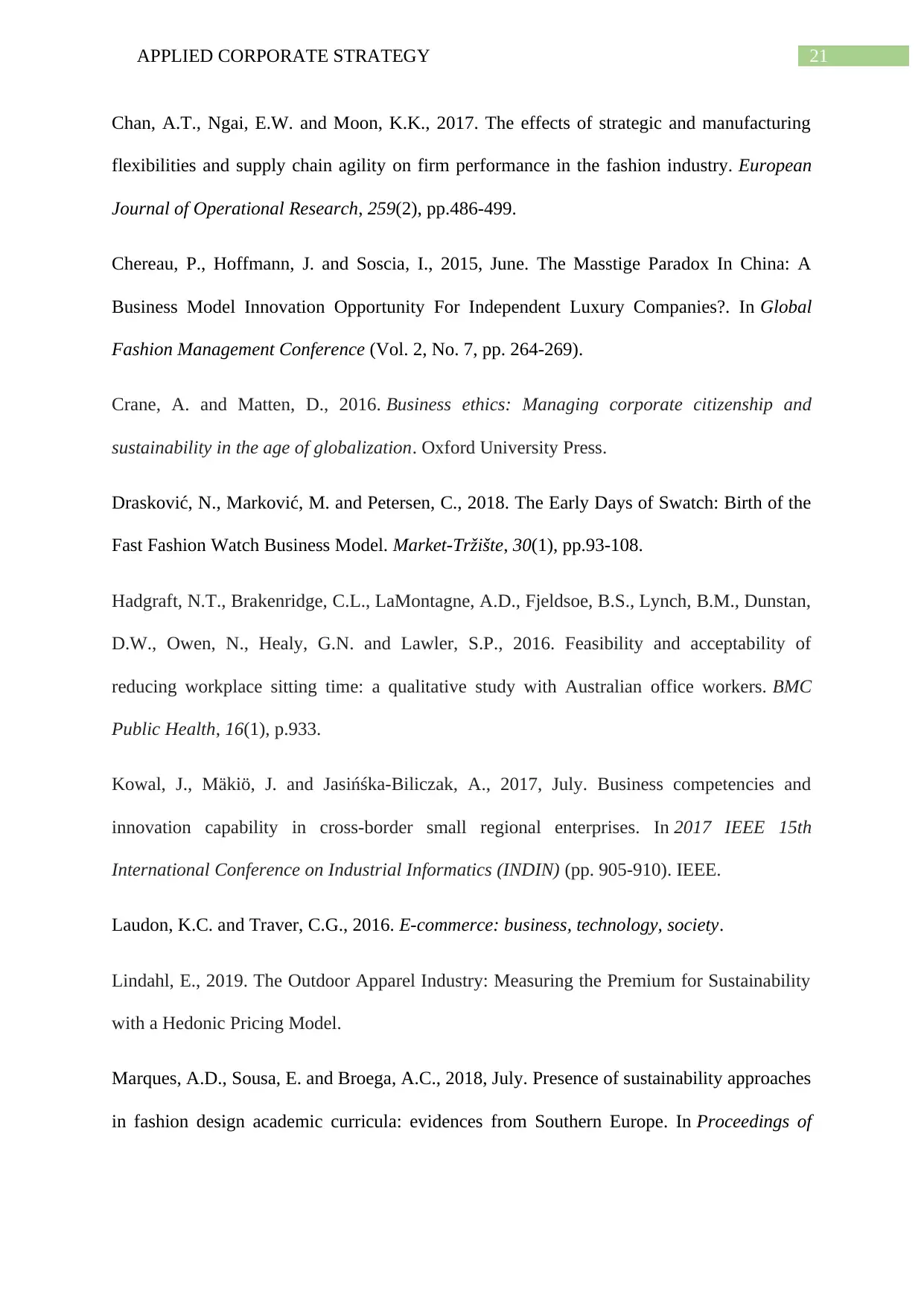
21APPLIED CORPORATE STRATEGY
Chan, A.T., Ngai, E.W. and Moon, K.K., 2017. The effects of strategic and manufacturing
flexibilities and supply chain agility on firm performance in the fashion industry. European
Journal of Operational Research, 259(2), pp.486-499.
Chereau, P., Hoffmann, J. and Soscia, I., 2015, June. The Masstige Paradox In China: A
Business Model Innovation Opportunity For Independent Luxury Companies?. In Global
Fashion Management Conference (Vol. 2, No. 7, pp. 264-269).
Crane, A. and Matten, D., 2016. Business ethics: Managing corporate citizenship and
sustainability in the age of globalization. Oxford University Press.
Drasković, N., Marković, M. and Petersen, C., 2018. The Early Days of Swatch: Birth of the
Fast Fashion Watch Business Model. Market-Tržište, 30(1), pp.93-108.
Hadgraft, N.T., Brakenridge, C.L., LaMontagne, A.D., Fjeldsoe, B.S., Lynch, B.M., Dunstan,
D.W., Owen, N., Healy, G.N. and Lawler, S.P., 2016. Feasibility and acceptability of
reducing workplace sitting time: a qualitative study with Australian office workers. BMC
Public Health, 16(1), p.933.
Kowal, J., Mäkiö, J. and Jasińśka-Biliczak, A., 2017, July. Business competencies and
innovation capability in cross-border small regional enterprises. In 2017 IEEE 15th
International Conference on Industrial Informatics (INDIN) (pp. 905-910). IEEE.
Laudon, K.C. and Traver, C.G., 2016. E-commerce: business, technology, society.
Lindahl, E., 2019. The Outdoor Apparel Industry: Measuring the Premium for Sustainability
with a Hedonic Pricing Model.
Marques, A.D., Sousa, E. and Broega, A.C., 2018, July. Presence of sustainability approaches
in fashion design academic curricula: evidences from Southern Europe. In Proceedings of
Chan, A.T., Ngai, E.W. and Moon, K.K., 2017. The effects of strategic and manufacturing
flexibilities and supply chain agility on firm performance in the fashion industry. European
Journal of Operational Research, 259(2), pp.486-499.
Chereau, P., Hoffmann, J. and Soscia, I., 2015, June. The Masstige Paradox In China: A
Business Model Innovation Opportunity For Independent Luxury Companies?. In Global
Fashion Management Conference (Vol. 2, No. 7, pp. 264-269).
Crane, A. and Matten, D., 2016. Business ethics: Managing corporate citizenship and
sustainability in the age of globalization. Oxford University Press.
Drasković, N., Marković, M. and Petersen, C., 2018. The Early Days of Swatch: Birth of the
Fast Fashion Watch Business Model. Market-Tržište, 30(1), pp.93-108.
Hadgraft, N.T., Brakenridge, C.L., LaMontagne, A.D., Fjeldsoe, B.S., Lynch, B.M., Dunstan,
D.W., Owen, N., Healy, G.N. and Lawler, S.P., 2016. Feasibility and acceptability of
reducing workplace sitting time: a qualitative study with Australian office workers. BMC
Public Health, 16(1), p.933.
Kowal, J., Mäkiö, J. and Jasińśka-Biliczak, A., 2017, July. Business competencies and
innovation capability in cross-border small regional enterprises. In 2017 IEEE 15th
International Conference on Industrial Informatics (INDIN) (pp. 905-910). IEEE.
Laudon, K.C. and Traver, C.G., 2016. E-commerce: business, technology, society.
Lindahl, E., 2019. The Outdoor Apparel Industry: Measuring the Premium for Sustainability
with a Hedonic Pricing Model.
Marques, A.D., Sousa, E. and Broega, A.C., 2018, July. Presence of sustainability approaches
in fashion design academic curricula: evidences from Southern Europe. In Proceedings of
Secure Best Marks with AI Grader
Need help grading? Try our AI Grader for instant feedback on your assignments.
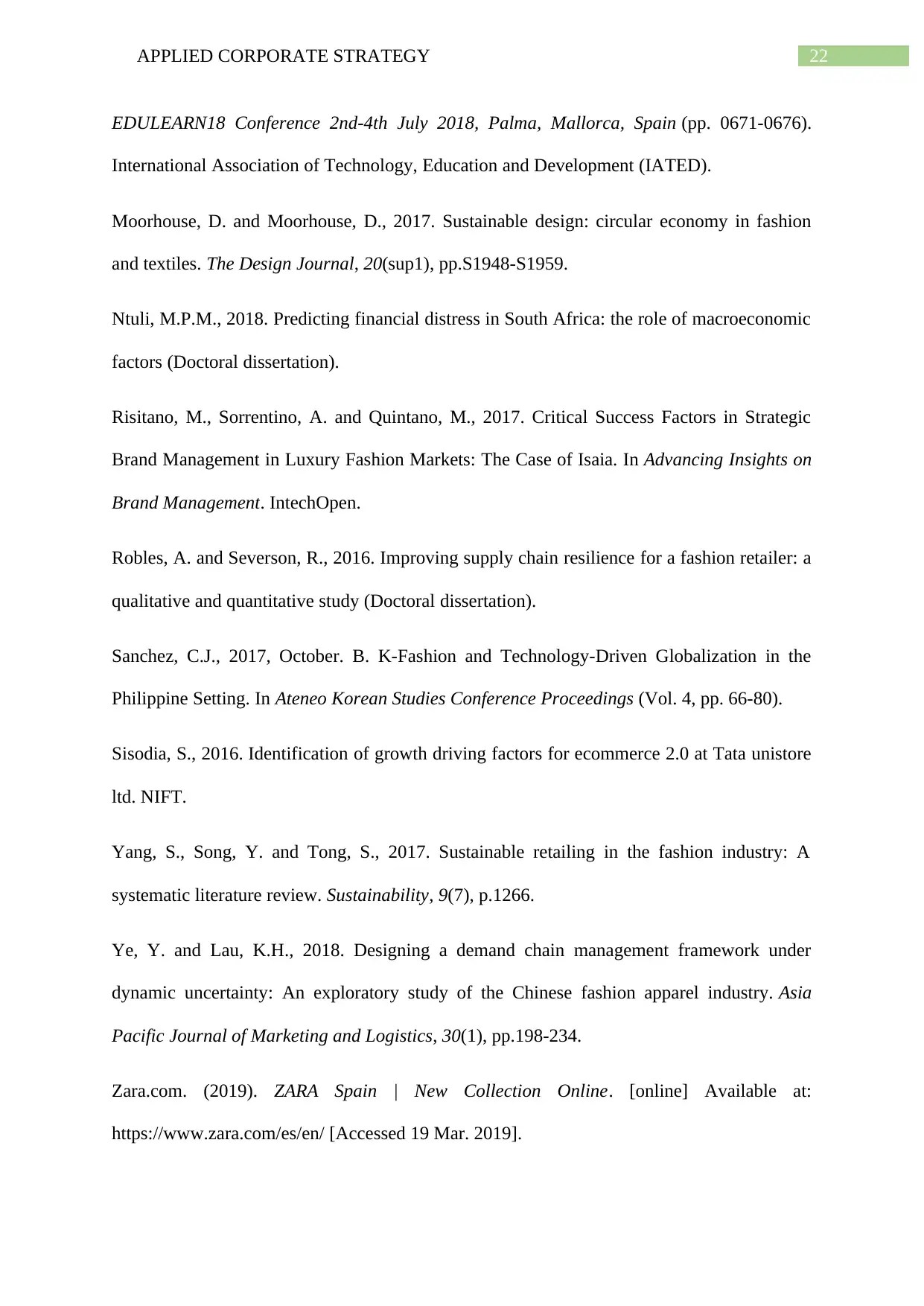
22APPLIED CORPORATE STRATEGY
EDULEARN18 Conference 2nd-4th July 2018, Palma, Mallorca, Spain (pp. 0671-0676).
International Association of Technology, Education and Development (IATED).
Moorhouse, D. and Moorhouse, D., 2017. Sustainable design: circular economy in fashion
and textiles. The Design Journal, 20(sup1), pp.S1948-S1959.
Ntuli, M.P.M., 2018. Predicting financial distress in South Africa: the role of macroeconomic
factors (Doctoral dissertation).
Risitano, M., Sorrentino, A. and Quintano, M., 2017. Critical Success Factors in Strategic
Brand Management in Luxury Fashion Markets: The Case of Isaia. In Advancing Insights on
Brand Management. IntechOpen.
Robles, A. and Severson, R., 2016. Improving supply chain resilience for a fashion retailer: a
qualitative and quantitative study (Doctoral dissertation).
Sanchez, C.J., 2017, October. B. K-Fashion and Technology-Driven Globalization in the
Philippine Setting. In Ateneo Korean Studies Conference Proceedings (Vol. 4, pp. 66-80).
Sisodia, S., 2016. Identification of growth driving factors for ecommerce 2.0 at Tata unistore
ltd. NIFT.
Yang, S., Song, Y. and Tong, S., 2017. Sustainable retailing in the fashion industry: A
systematic literature review. Sustainability, 9(7), p.1266.
Ye, Y. and Lau, K.H., 2018. Designing a demand chain management framework under
dynamic uncertainty: An exploratory study of the Chinese fashion apparel industry. Asia
Pacific Journal of Marketing and Logistics, 30(1), pp.198-234.
Zara.com. (2019). ZARA Spain | New Collection Online. [online] Available at:
https://www.zara.com/es/en/ [Accessed 19 Mar. 2019].
EDULEARN18 Conference 2nd-4th July 2018, Palma, Mallorca, Spain (pp. 0671-0676).
International Association of Technology, Education and Development (IATED).
Moorhouse, D. and Moorhouse, D., 2017. Sustainable design: circular economy in fashion
and textiles. The Design Journal, 20(sup1), pp.S1948-S1959.
Ntuli, M.P.M., 2018. Predicting financial distress in South Africa: the role of macroeconomic
factors (Doctoral dissertation).
Risitano, M., Sorrentino, A. and Quintano, M., 2017. Critical Success Factors in Strategic
Brand Management in Luxury Fashion Markets: The Case of Isaia. In Advancing Insights on
Brand Management. IntechOpen.
Robles, A. and Severson, R., 2016. Improving supply chain resilience for a fashion retailer: a
qualitative and quantitative study (Doctoral dissertation).
Sanchez, C.J., 2017, October. B. K-Fashion and Technology-Driven Globalization in the
Philippine Setting. In Ateneo Korean Studies Conference Proceedings (Vol. 4, pp. 66-80).
Sisodia, S., 2016. Identification of growth driving factors for ecommerce 2.0 at Tata unistore
ltd. NIFT.
Yang, S., Song, Y. and Tong, S., 2017. Sustainable retailing in the fashion industry: A
systematic literature review. Sustainability, 9(7), p.1266.
Ye, Y. and Lau, K.H., 2018. Designing a demand chain management framework under
dynamic uncertainty: An exploratory study of the Chinese fashion apparel industry. Asia
Pacific Journal of Marketing and Logistics, 30(1), pp.198-234.
Zara.com. (2019). ZARA Spain | New Collection Online. [online] Available at:
https://www.zara.com/es/en/ [Accessed 19 Mar. 2019].
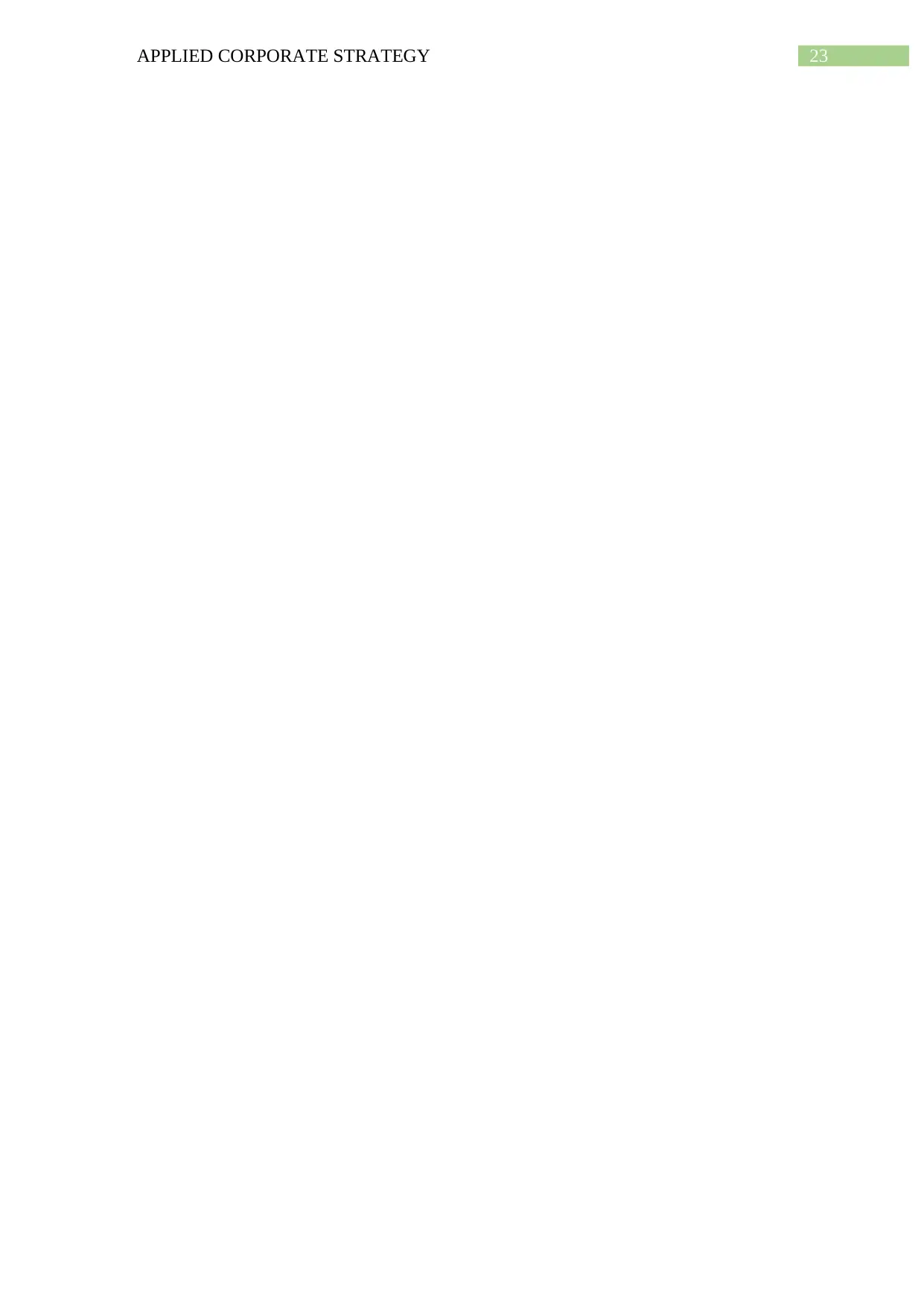
23APPLIED CORPORATE STRATEGY
1 out of 24
Related Documents
Your All-in-One AI-Powered Toolkit for Academic Success.
+13062052269
info@desklib.com
Available 24*7 on WhatsApp / Email
![[object Object]](/_next/static/media/star-bottom.7253800d.svg)
Unlock your academic potential
© 2024 | Zucol Services PVT LTD | All rights reserved.





